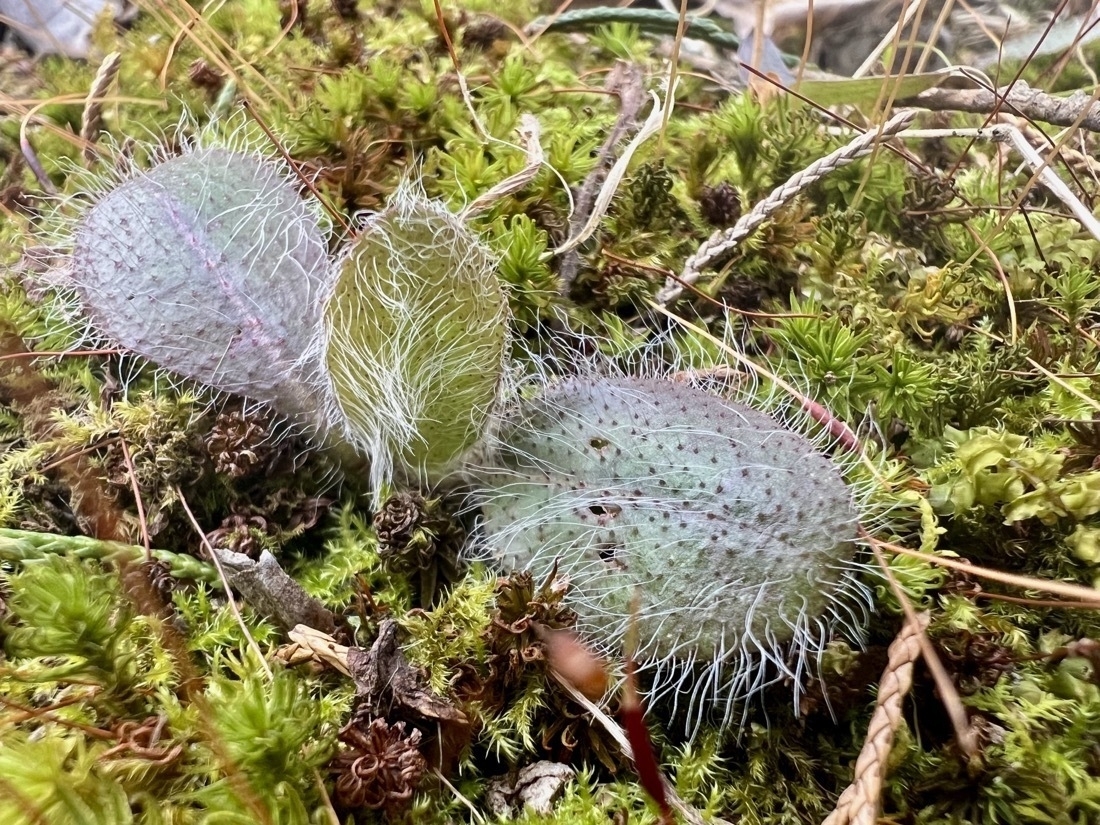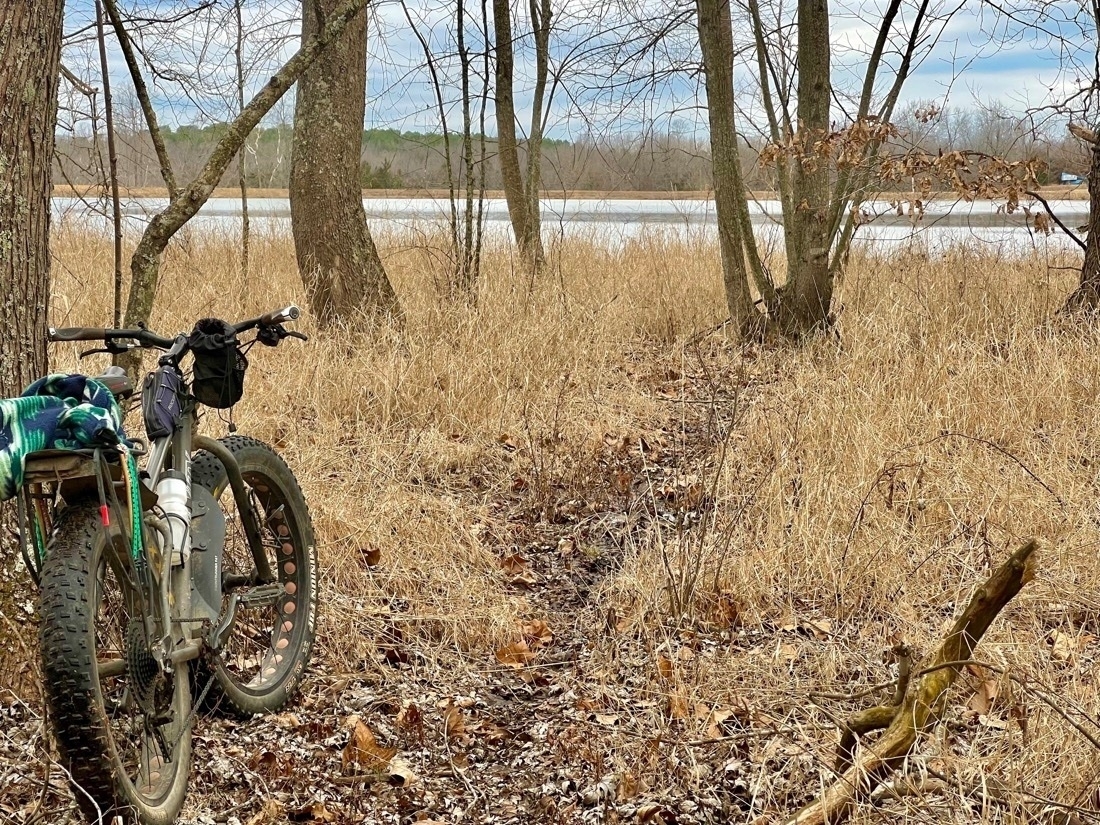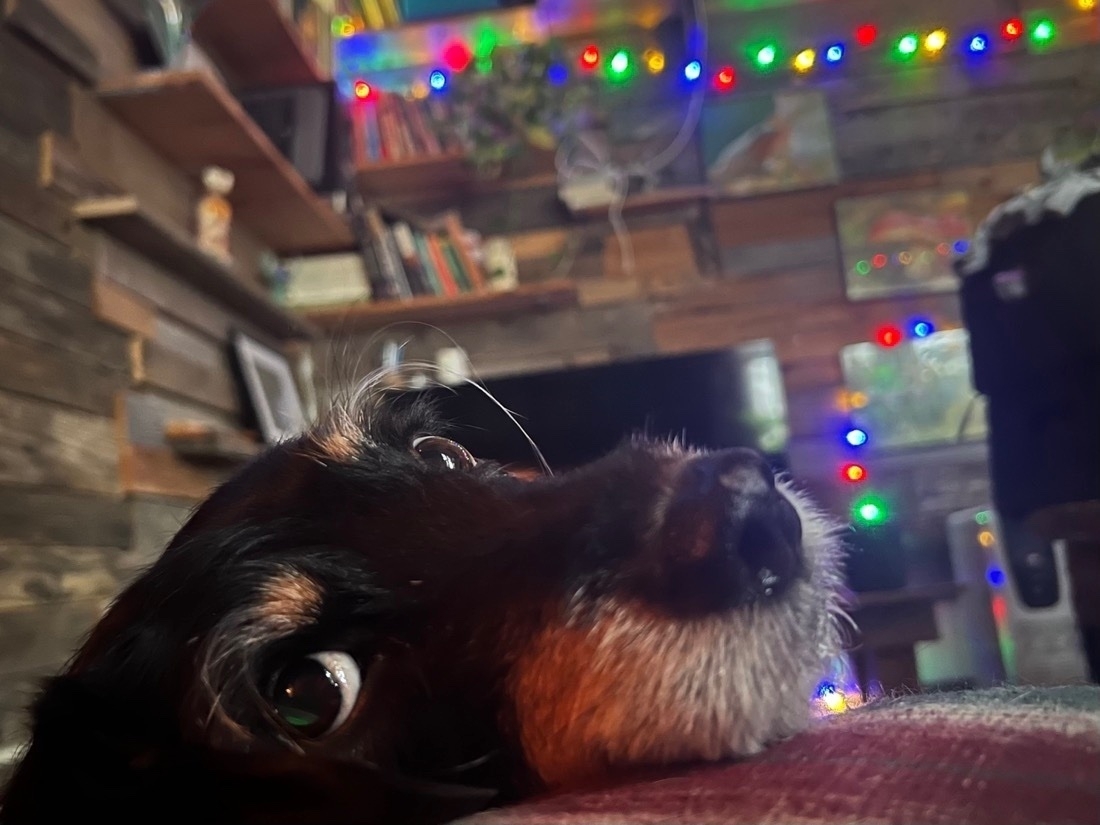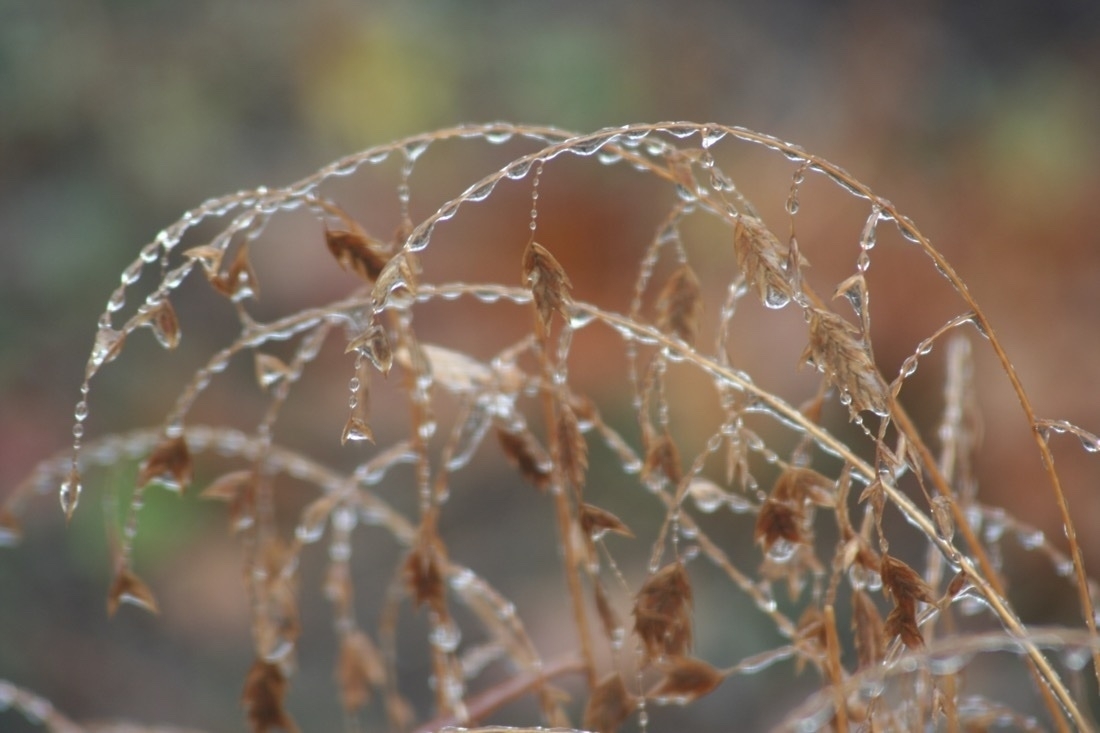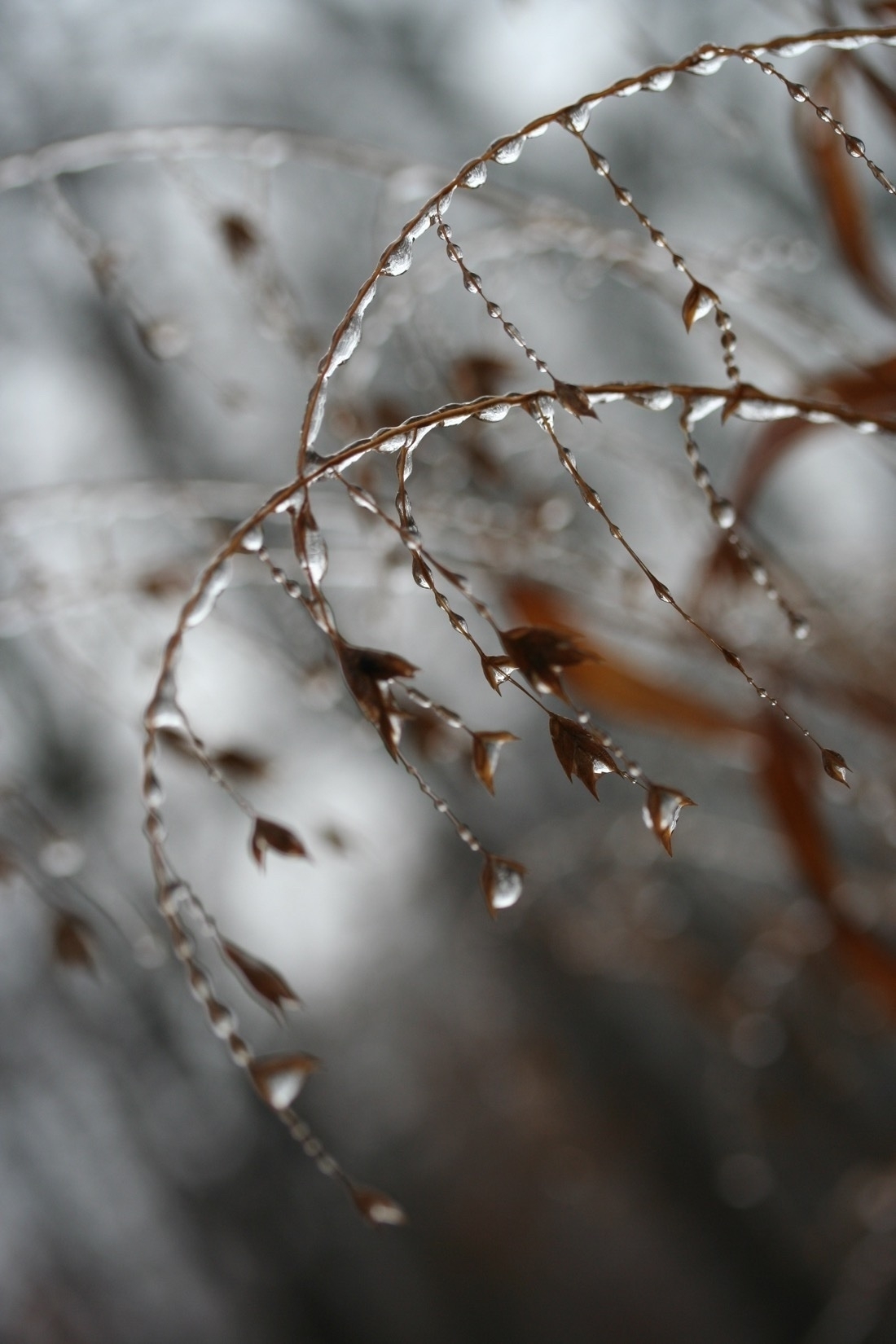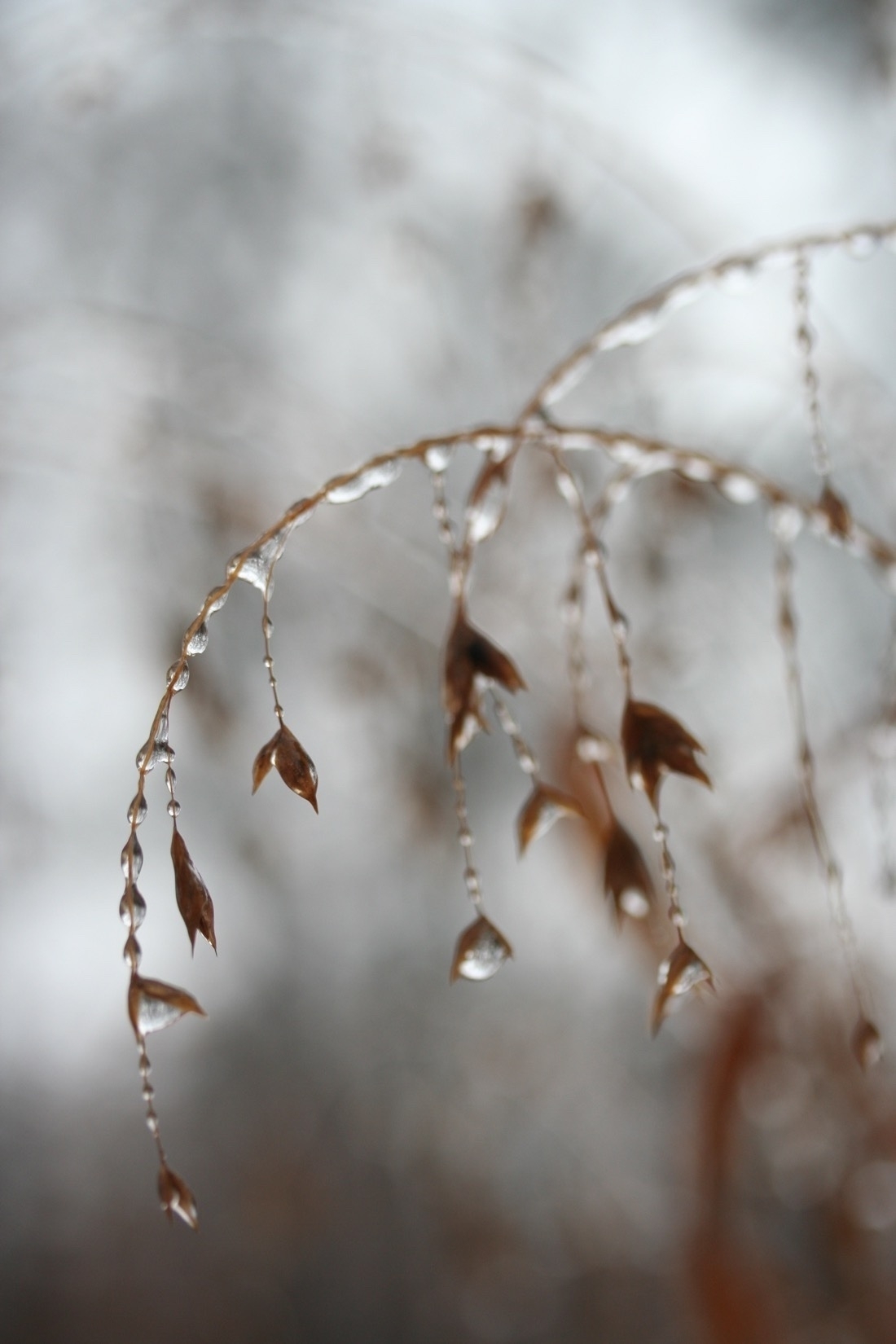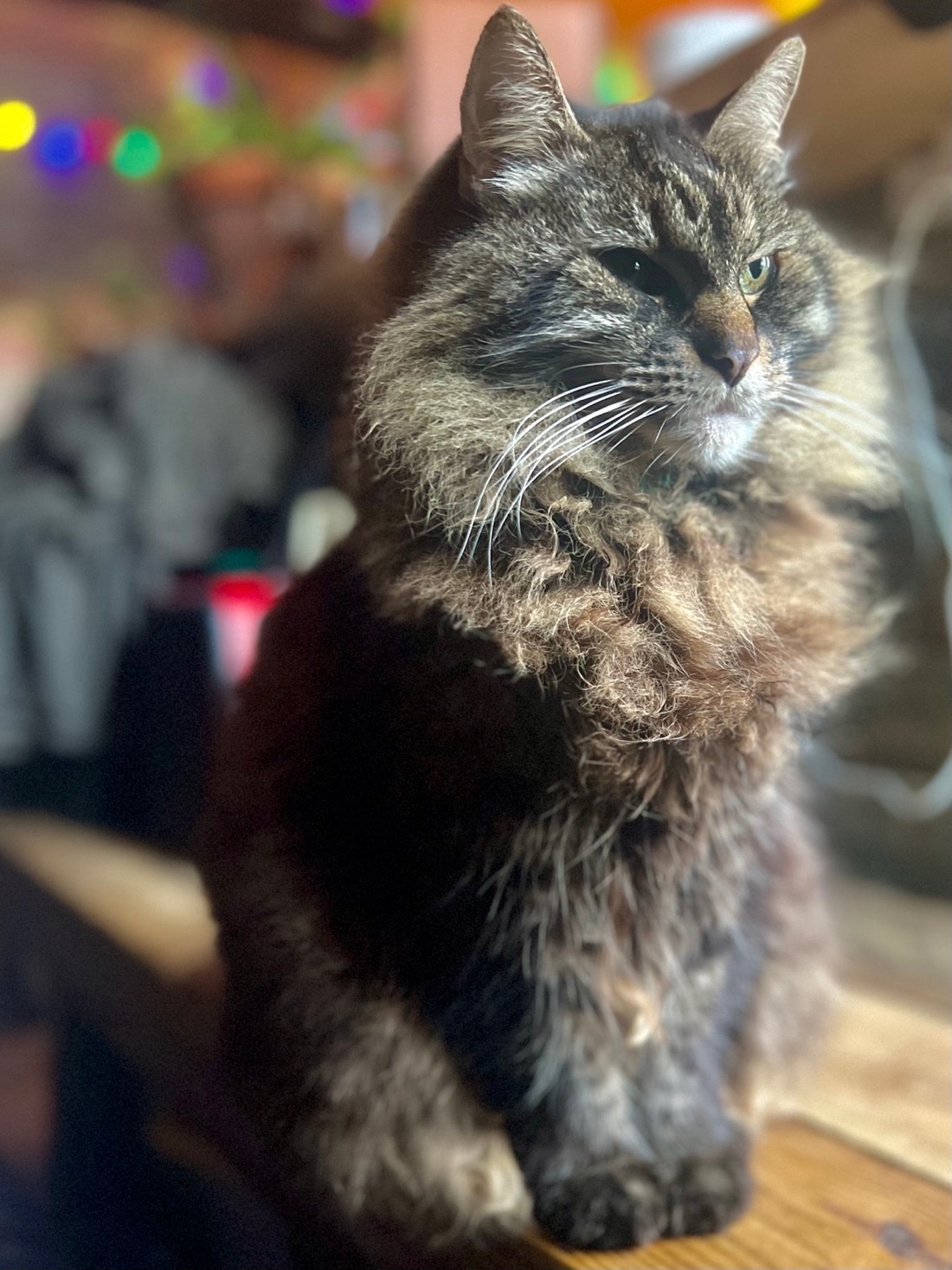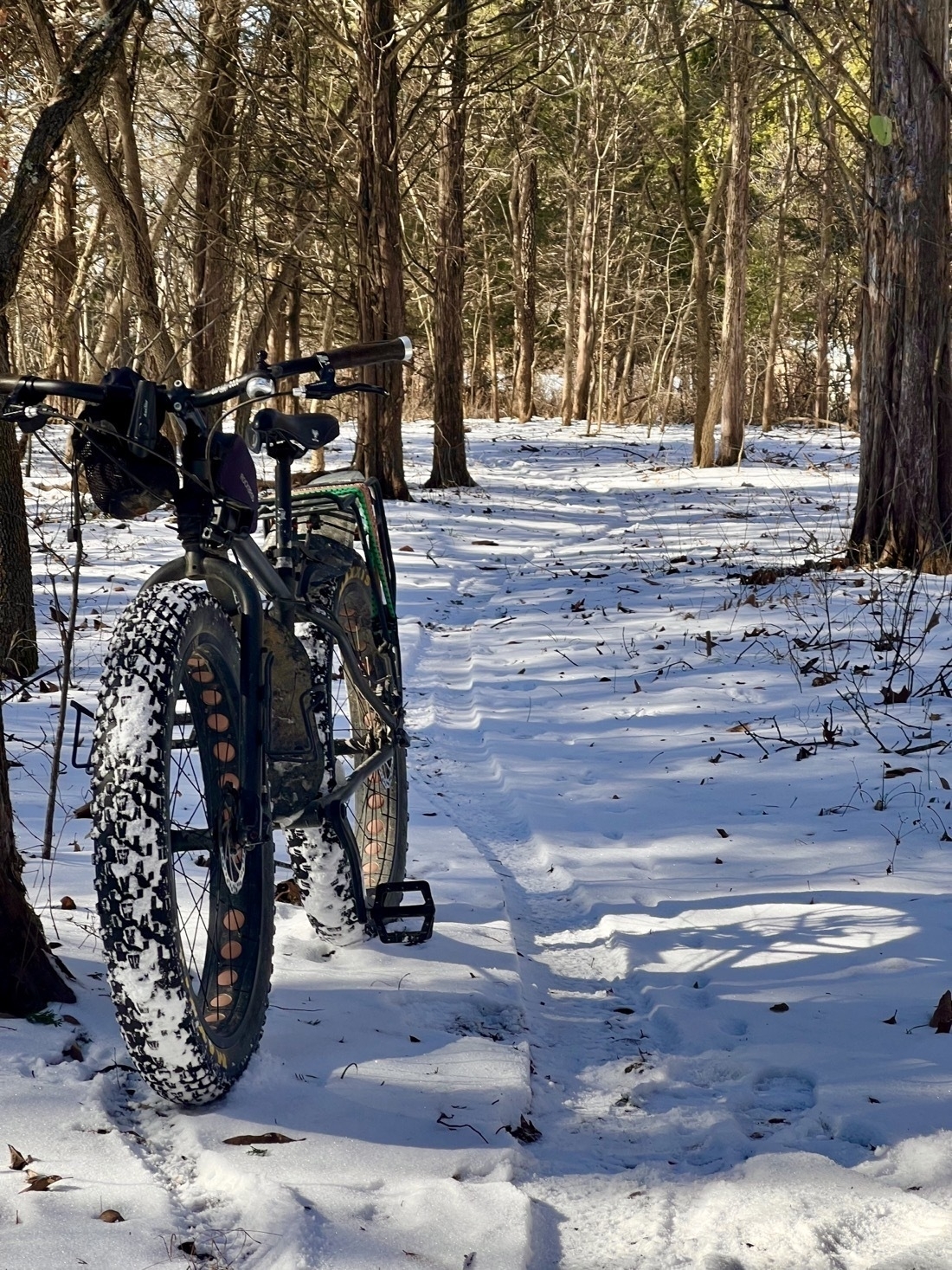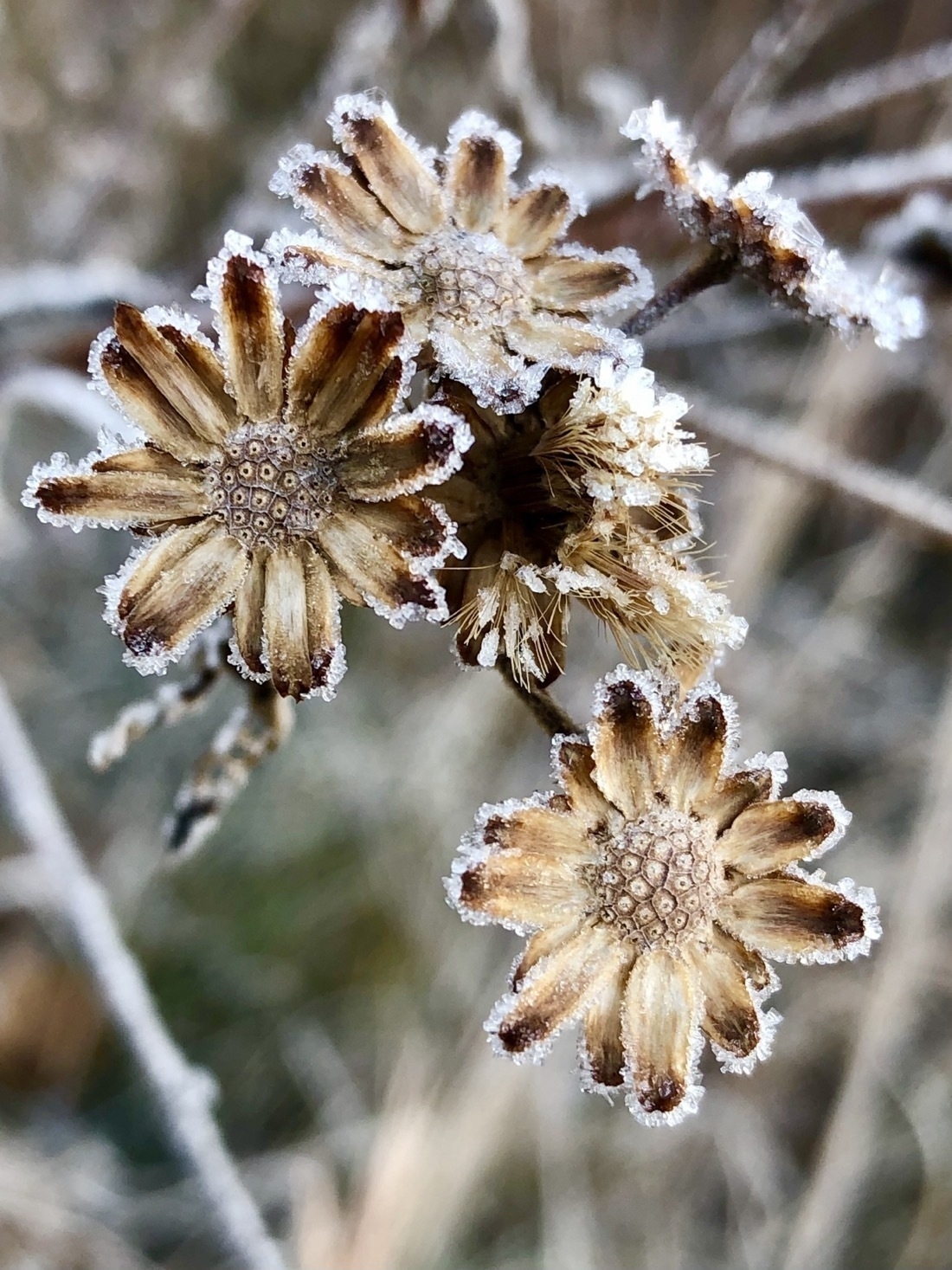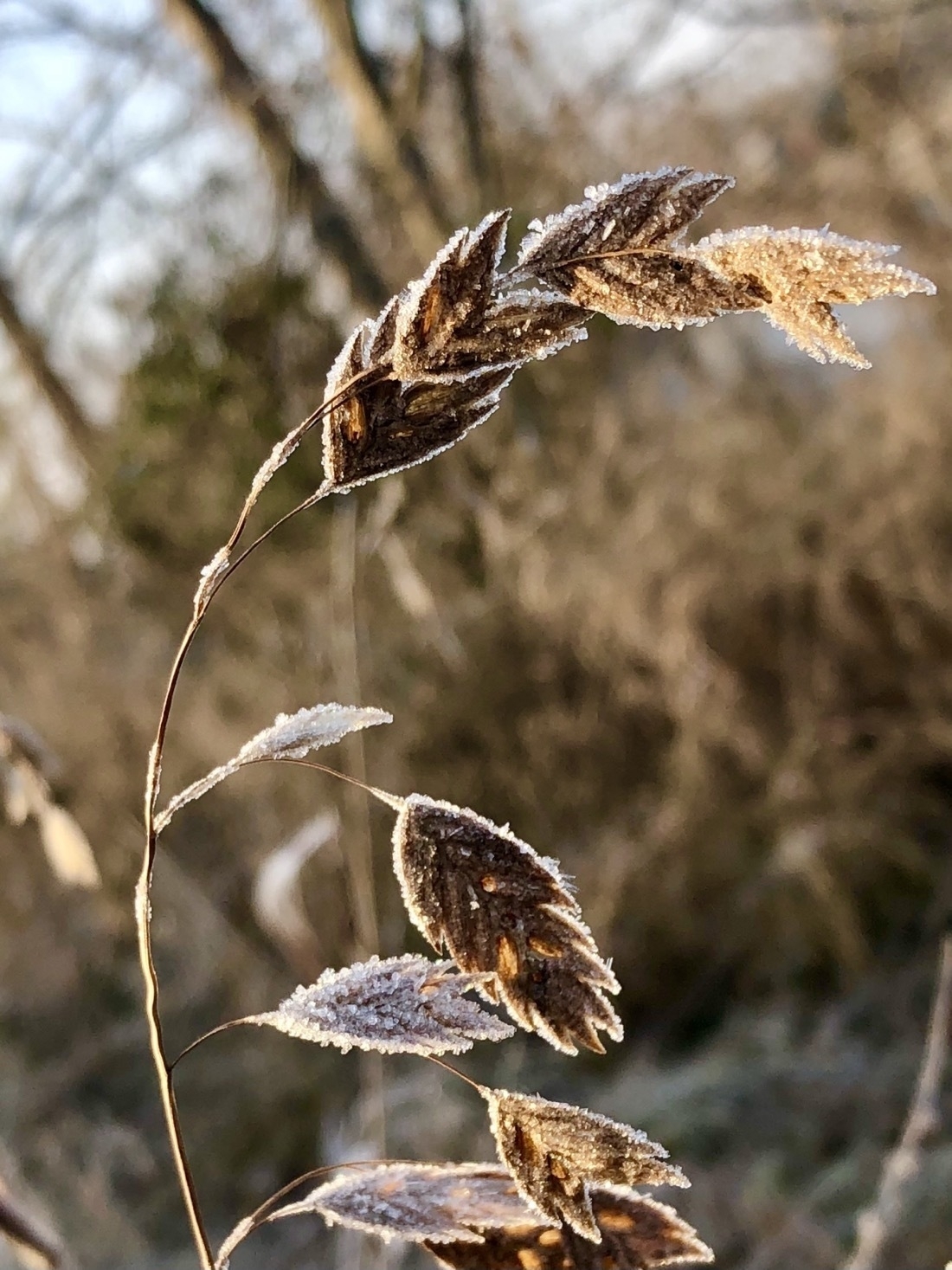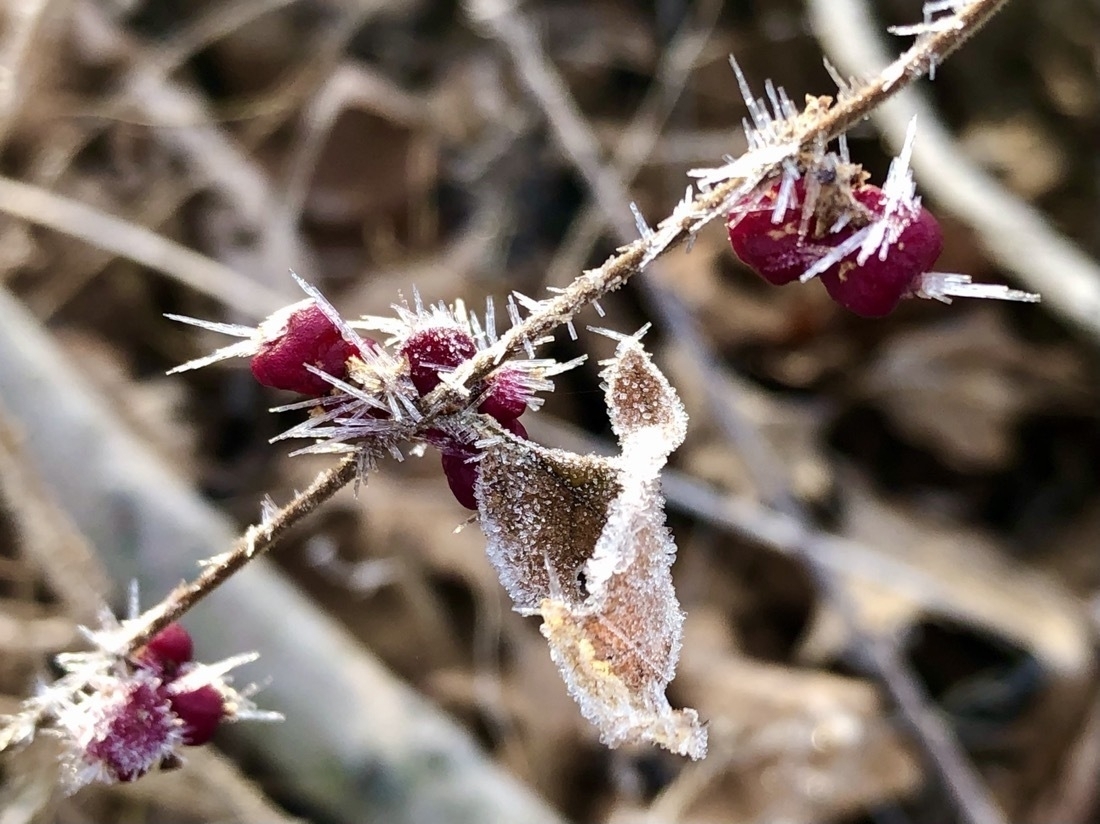The moss bell mushroom growing from the moss is really tiny! Probably less than 12 millimeters.
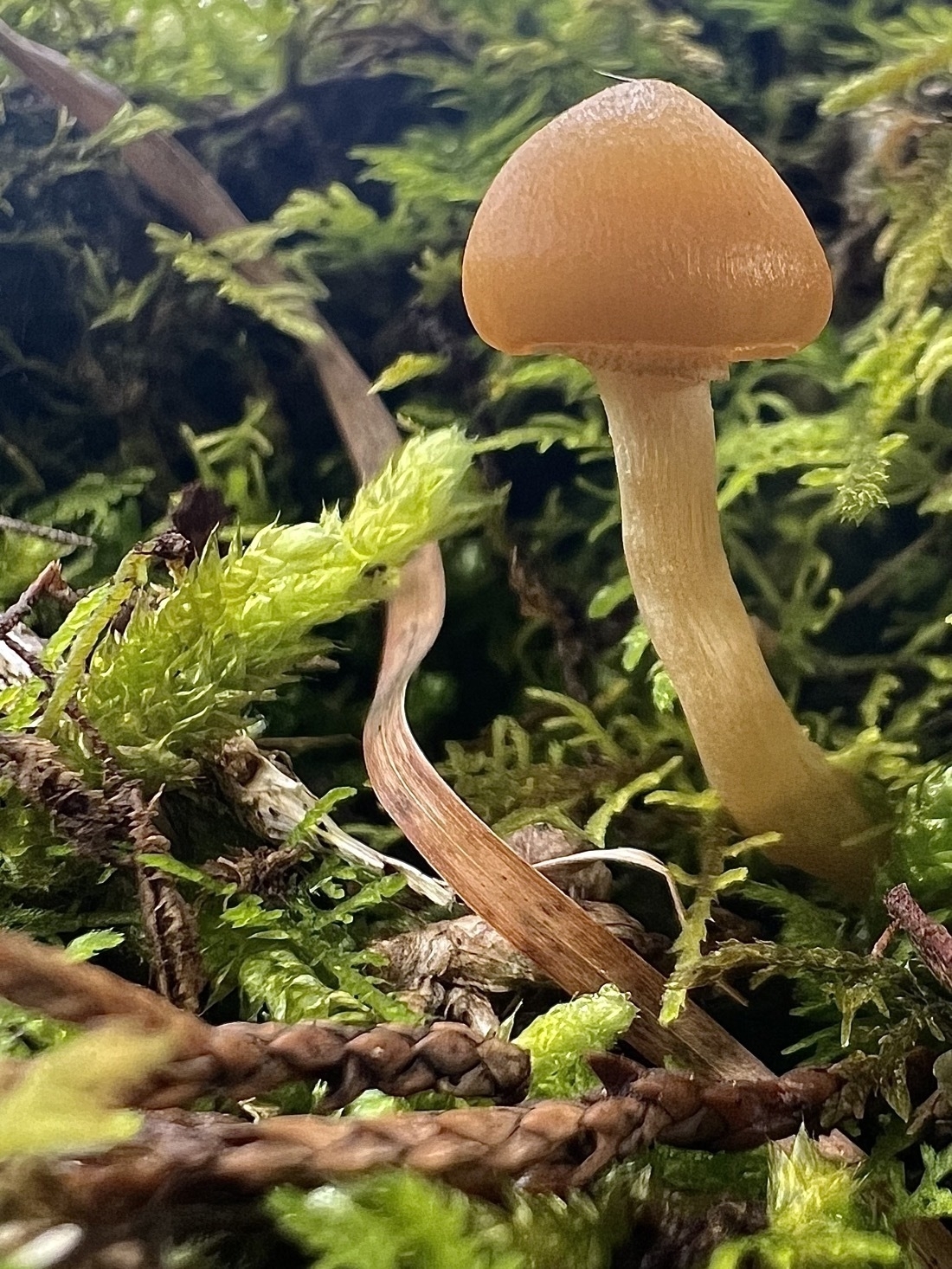
Galerina, Moss Bells

Cladonia, Pixie Cup Lichen
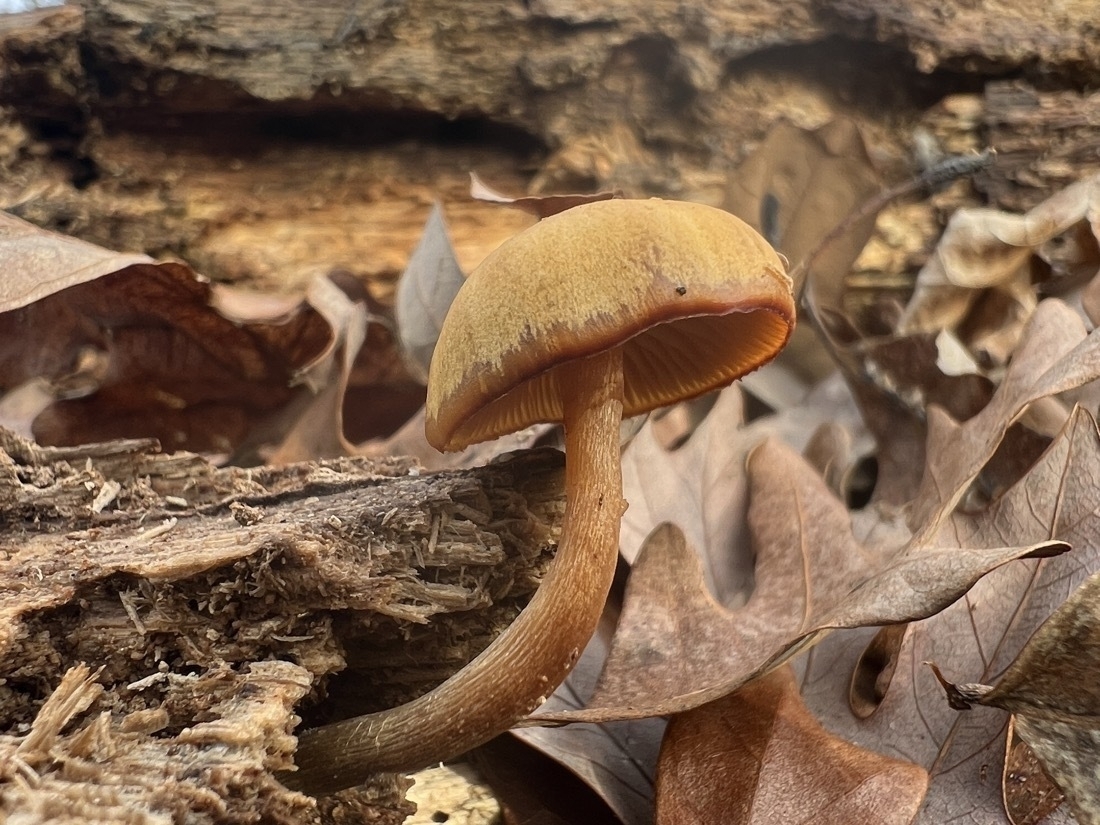
Galerina, Moss Bells
Mycena galericulata, commonly known as the common bonnet, the toque mycena, the common mycena or the rosy-gill fairy helmet. Not edible.
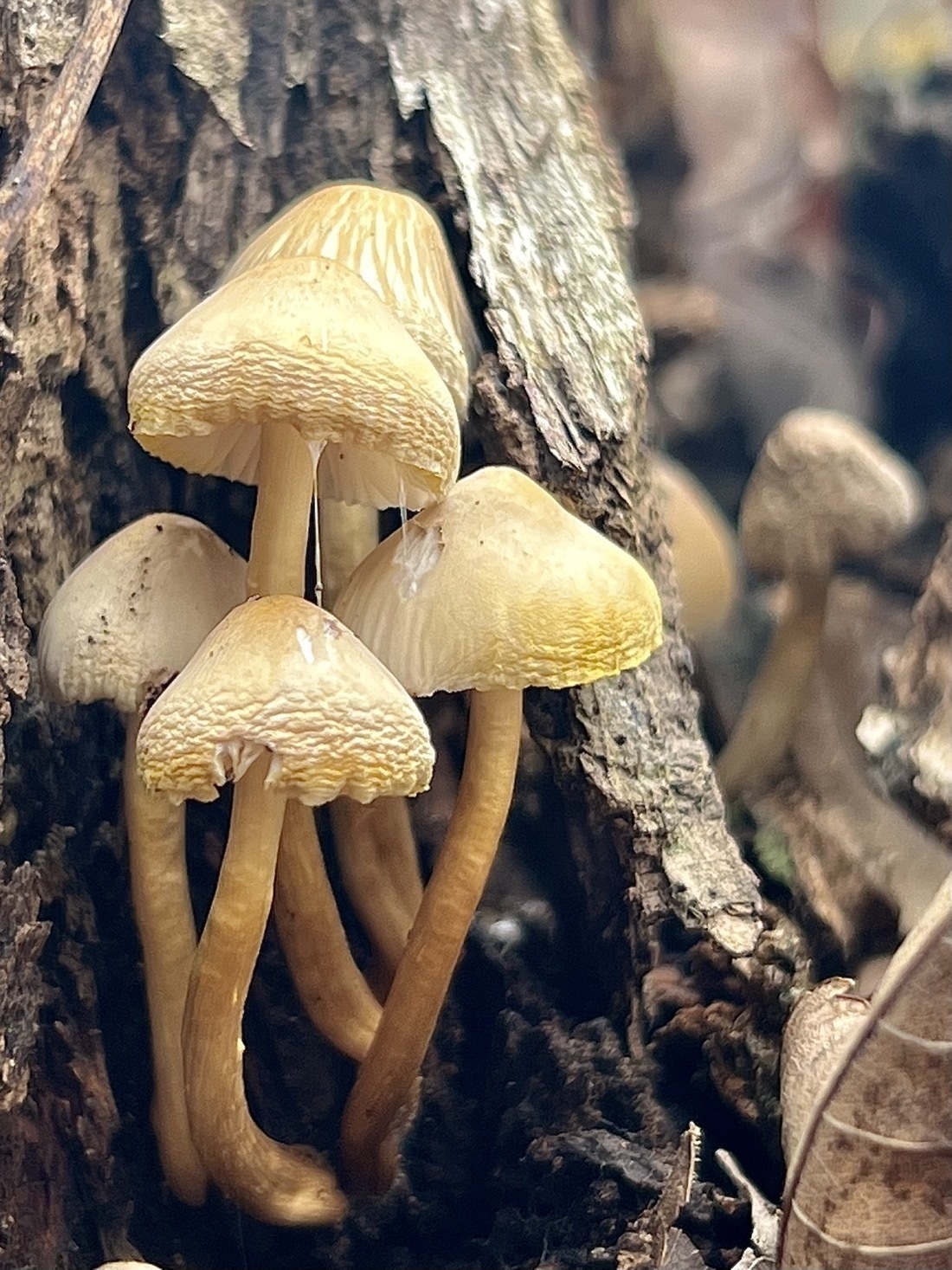
Cladonia peziziformis or the turban cup lichen
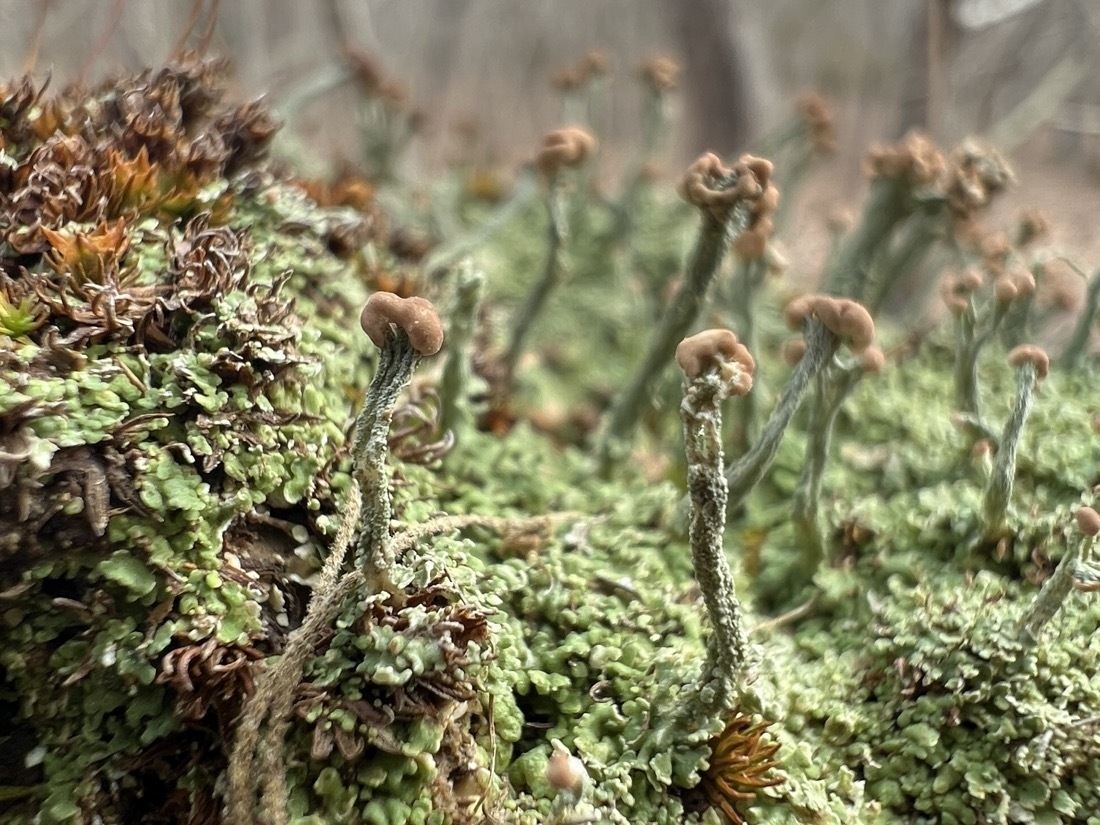
Laccaria laccata, commonly known as the deceiver, or waxy laccaria. Edible

Photo from yesterday's trail ride. Taken along the backside creek inflow to the lake. Some pretty grasses in this area.
Celebrating 20 Years of Apple's Safari and Keynote

On January 7, 2003 Apple introduced two new apps, both of which proved to be significant steps for the still young Mac OS X platform. The apps were a surprise to the public and press and were important steps in a much larger process of Apple building it's own ecosystem of applications which it continues today.
Of the two, Safari was likely the most significant. Apple's press release:
MACWORLD EXPO, SAN FRANCISCO—January 7, 2003—Apple® today unveiled Safari™, the fastest and easiest to use web browser ever created for the Mac®. Safari’s highly-tuned rendering engine loads pages over three times faster than Microsoft’s Internet Explorer for the Mac and runs Javascript over twice as fast. Safari’s innovative features include Google search capabilities integrated directly into the toolbar; SnapBack, a new way to instantly snap back up to search results or the top level of any website after browsing down one or more levels; a completely new way to name, organize and present bookmarks; and automatic “pop-up” ad blocking.
Safari began it's life at Apple with the WebKit project which was a fork of the open source KHTML layout engine. Don Melton started the WebKit project at Apple on June 25, 2001. He's got a great post about Safari on his blog, published 2013.
Apple's Safari Page on Web Archive
I remember being very excited as I'm sure many were. The significance of Apple releasing its own web browser was pretty clear to Apple users. My take-away at the time was that Apple didn't want to depend on Microsoft for what was becoming one of the most important apps on a computer. 20 years later and Safari continues and is now the second most used browser largely due to the introduction of the iPhone and iPad. While I tried various browsers over the years Safari remained my primary browser and today is the only one I use for day-to-day browsing.
But their big app announcements for that day were not finished.
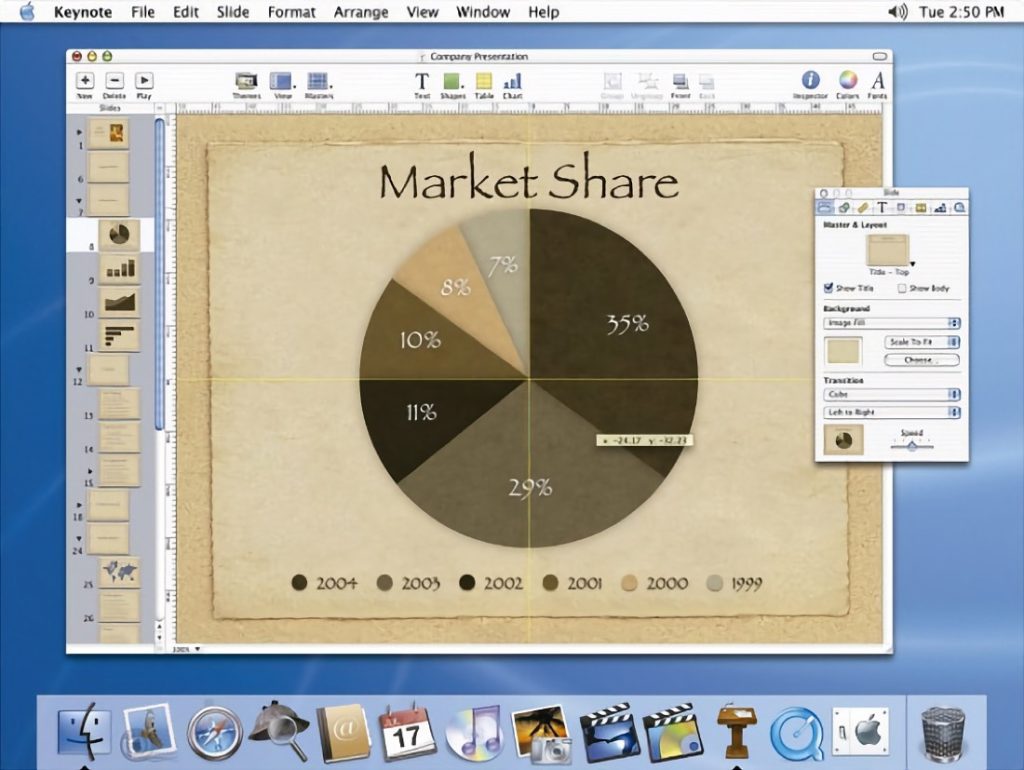
The other significant surprise of the day was the release a new presentation application: Keynote. This release seemed to further underscore Apple's intention to become more self-reliant in it's app offerings. As a user of the Appleworks suite of applications I was very excited at the new release as it filled a gap. Though we were unaware at the time it would prove to be the first of a new suite of applications that Apple would release over the next few years called iWork.
The app was originally designed as presentation software for Steve Jobs, Keynote originally retailed as a stand alone application for $99. Pages was added in 2005 and Numbers in 2007. While Microsoft continued to provide its Office apps, Keynote quickly became a favorite of Mac users due to the ease of use and quality of the presentation. I've used Keynote many times over the years and it's been a pleasure to create presentations with it.
“Using Keynote is like having a professional graphics department to create your slides,” said Steve Jobs, Apple’s CEO. “This is the application to use when your presentation really counts.”
Keynote includes 12 Apple-designed themes featuring coordinated backgrounds, fonts, colors, bullets, tables and charts. Users can change the theme of their presentation any number of times, modify an existing theme to their liking, or create custom themes to give their presentations a totally unique look.
I keep seeing this idea being repeated that because BP concocted the idea of the Carbon Footprint to shift blame to individuals that somehow individuals are not responsible. That really, it’s the corporations that are to blame. Bullshit. Yes, of course corporations are to blame. Capitalism has created this never-ending cycle of hyper consumerism. But humans, especially those in countries like the US have happily endorsed it. To this day most people I know refuse to take any responsibility for their role. They drive, fly and consume as much as they please and are perfectly happy continuing that lifestyle. They love the message that they’re not responsible.
I’m not suggesting that the policies of government and the fundamental practices of industrial-corporate capitalism are blameless. Of course they play a key role in perpetuating climate collapse, habitat destruction, etc.
But let’s not pretend that our individual behaviors of mindless, obedient consumption to not complete the cycle. We have allowed ourselves to be re-defined by capitalism from citizens to consumers. We insist on maximum comfort, consumption and convenience at the least expense. We are participants in this equation.
And I’d add that when we see attempts to suggest that we modify our behaviors, to purchase less, to consume less, to change our diet, etc, people push back against the solutions. We don’t want to make the changes that are necessary. We don’t want to do it voluntarily on our own and we’re going to be unhappy when laws are made that restrict our behavior. Legislators of law know that the changes that need to be made will result in a transition to a very different way of living that will result in pushback.
I think a lot of people just want to believe that with new legislation we’ll magically have new technology and all will be fixed. That we can point our fingers at Big Oil and Big Auto. The idea being that there is an easy, magical technological fix that will just sort of happen with a magic wand.
But the hard truth is that for decades we’ve built a whole way of life, all of us, that is based on cheap fossil fuel energy. But this way of life is just a brief blip in human history. It’s only lasted a hundred years and already, it’s done. In only 100 years we’ve burned through enough to change the climate of our planet. And most of that in only the past few decades.
We now have a reckoning coming, be it the massive changes we need to embrace to just begin to curb the problem or the full-on massive collapse that seems most likely.
And we in the developed world, most notably countries like the US, bear the brunt of the responsibility. Not equally, of course, within each wealthy nation there are differences. Oligarchs like Elon Musk who happily fly their private jets on a regular basis obviously contribute far more than a wage worker driving to work. But again, on a whole, wealthier nations have burned more.
I don’t have a lot of hope that we’ll do nearly enough in the short time we have. But pretending our individual consumption doesn’t count for much is a sure way to continuing in the wrong direction.
“The problem is that there are a lot of people out there who don’t care… Many, maybe most, people aren’t as worried about saving the earth as they are worried about what other people think of them.”
Mockery: The Climate Movement’s Secret Weapon | by George Dillard
It’s impressive how large wind turbines have gotten, and, as a result, how far the prices have come down. The only limiting factor seems to be the speed at which they can be produced.
Wind turbines are already skyscraper-sized – is there any limit to how big they will get?
There’s been way too much talk and too little action and commitment, especially in the United States. The citizens of the US need to step up and take responsibility for the problems our standard of living and over consumption have caused.
I often see well meaning lefties proclaiming that it is largely the fault of the 1% and corporate capitalism. Sure, there are those that can be pointed to as doing the most damage, far beyond the average. Elon Musk taking private flights across the country or globe as casually as Americans drive to the big box store. But the middle class of the US does not get a pass on this. We’ve all gone along with hyper-consumerism for decades and readily push back against any notion of taking responsibility, of restraint. It’s bullshit to point the fingers at the emissions of corporations given that those emissions are coming as a result of our demand for goods. If we’re buying the products that drive production then we are also responsible.
More and bigger cars, bigger homes filled with more stuff and requiring more energy to heat and cool, are our responsibility. Millions of people in the US, allowing themselves to be defined as “consumers” continue to go along with the “American Dream” that is in fact a leading factor in the nightmare of existence for those suffering the brunt of the early years of climate collapse.
“I’ve been chronicling the increased frustration and anger of island states and vulnerable countries and small African nations and others around the world that feel victimised by the fact that they are a minuscule component of emissions,” he said. “And yet [they are] paying a very high price. Seventeen of the 20 most affected countries in the world, by the climate crisis, are in Africa, and yet 48 sub-Saharan countries total 0.55% of all emissions.”
John Kerry: rich countries must respond to developing world anger over climate | The Guardian
“Volunteers hope to bring native wildlife back into abundance by reestablishing grasslands that were wiped out after European settlement of Missouri. "
Chasmanthium latifolium, northern wood-oats, inland sea oats, northern sea oats, and river oats is a species of grass native to the central and eastern United States, Manitoba, and northeastern Mexico
192 Square Feet: Part 3
Previously: Part 1, Part 2 I shared about the first year of my tiny house life. Building the tiny house, setting up the garden and food forest during the first summer. Then, of course, learning about living in the tiny house during winter and what that means for keeping warm and keeping things working.
The following spring and summer were spent extending the garden, building a chickencoop-greenhouse and raising chickens and guineas, and setting up a bee hive. Oh, and some local farmer friends brought me an orphaned fawn. We also built the kids’ cabin, the third cabin, for Kerry and Greg’s kids. A wild goose showed up mid-summer and adopted me.
The chicken coop greenhouse came first for practical reasons. I needed a place for the young chickens! The idea was to have the two attached. In theory the greenhouse would help keep the chicken coop warm in the winter and the proximity of the coop to the greenhouse also made sense in terms of composting the chicken coop straw bedding that was full of chicken poop. I could haul the straw just 25 feet to a compost pile between the greenhouse and the garden.
Then the bees which were set-up in their new hive in late April. More about beekeeping an a future post. All went as planned. Until it didn’t.
Petunia the deer came to live with me in early June after a new farmer friend. Luckily we had a safe, enclosed area for her. More photos of her in another post.
I also set up 6 rain barrels on a frame behind my cabin. Each barrel held 50 gallons and they were upside down with a PVC pipe connecting them all via the built in screw lids. This arrangement allows the barrels to all fill at the same time because they are filling from the bottom up. The photo below was taken before everything was finished so the run-off was a haphazardly arranged salvaged gutter that carried water to my swale which was mulched and planted with pawpaws and rhubarb a well a a few herbs.
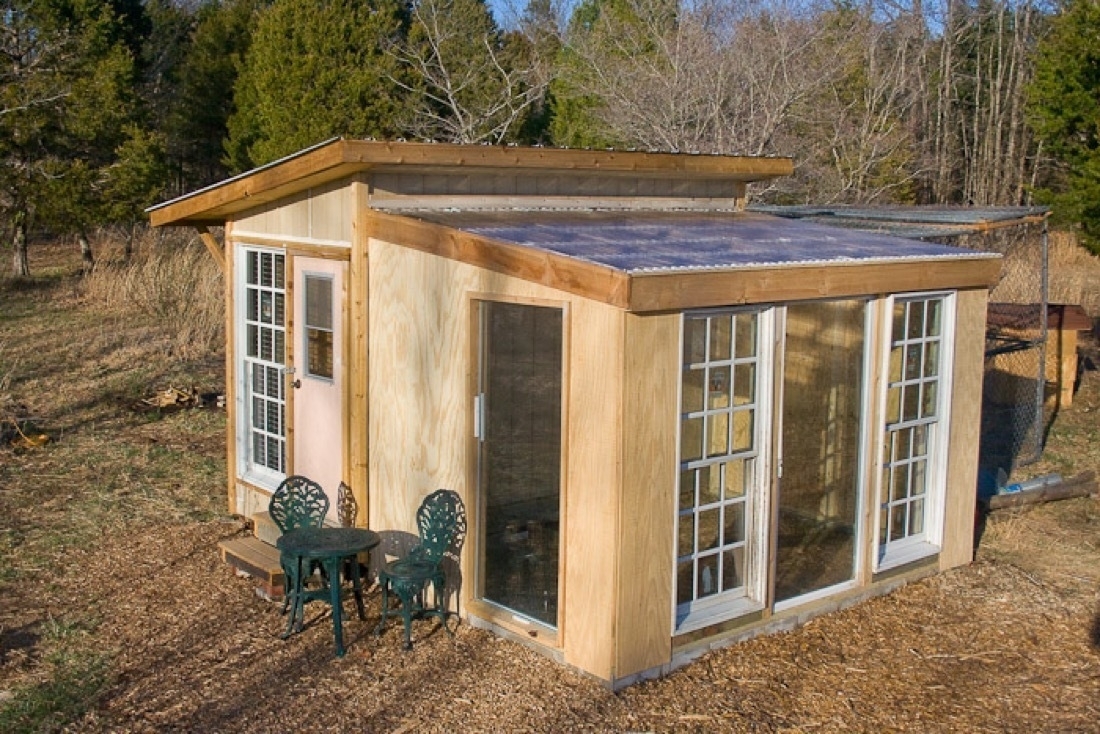 The newly finished chicken coop greenhouse.
The newly finished chicken coop greenhouse.
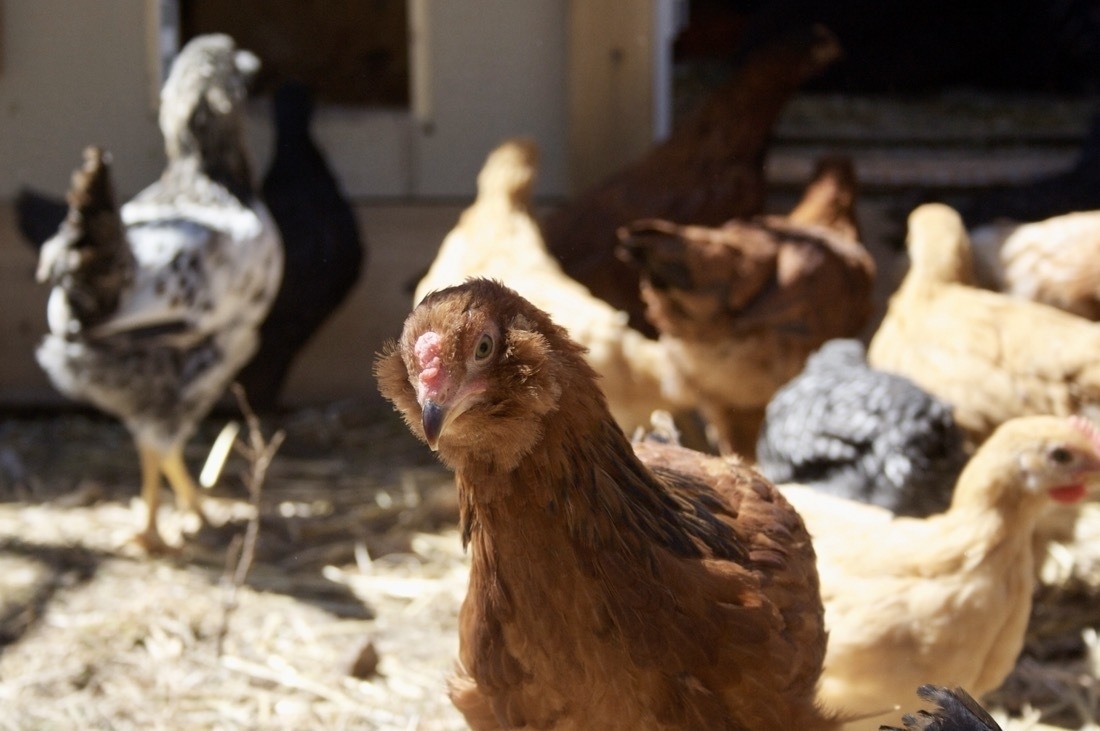 Happy chickens!
Happy chickens!
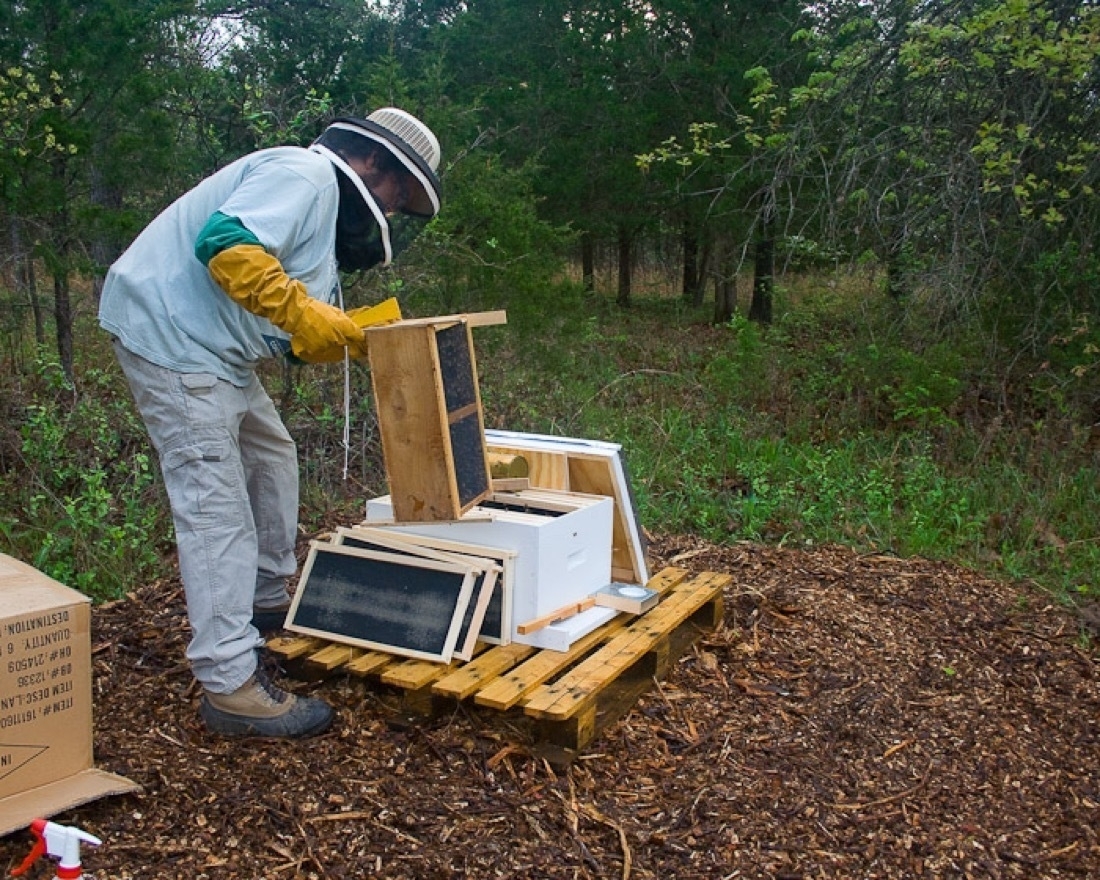 Setting up the new bees in their hive.
Setting up the new bees in their hive.
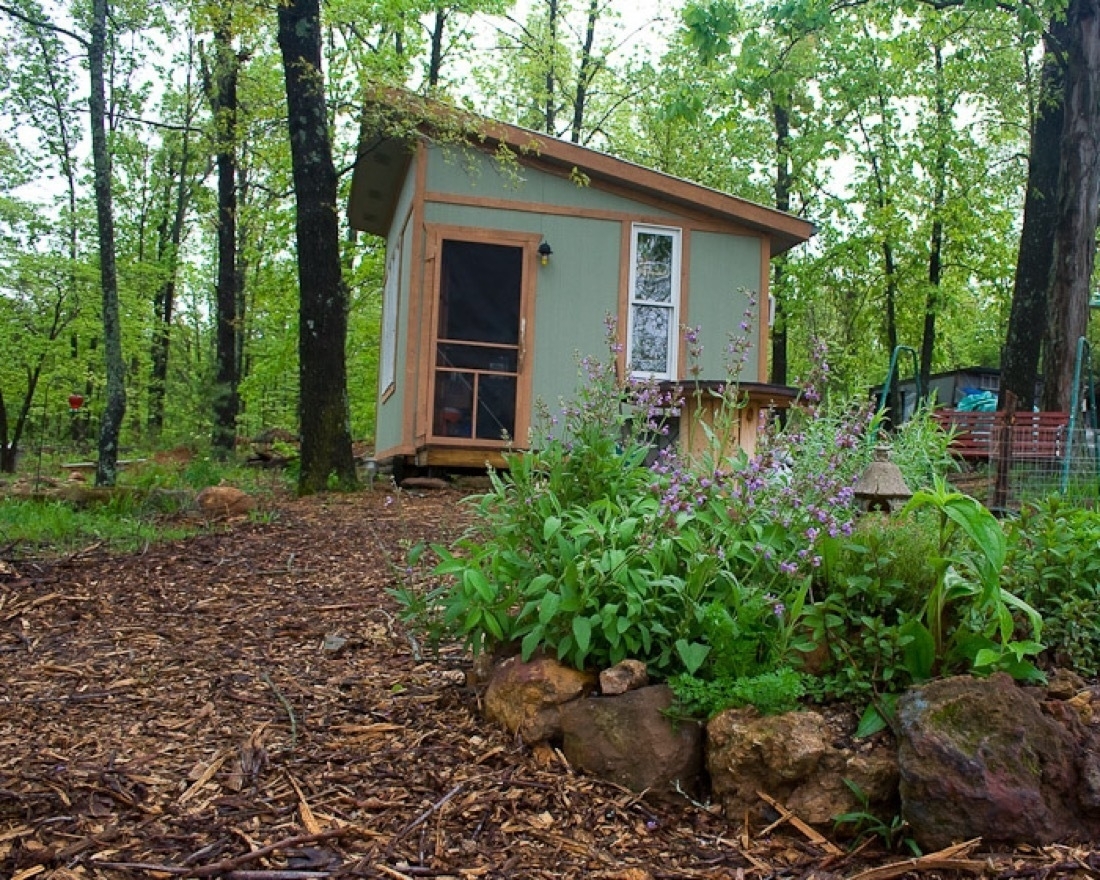 Herb spiral bed in front of my cabin.
Herb spiral bed in front of my cabin.
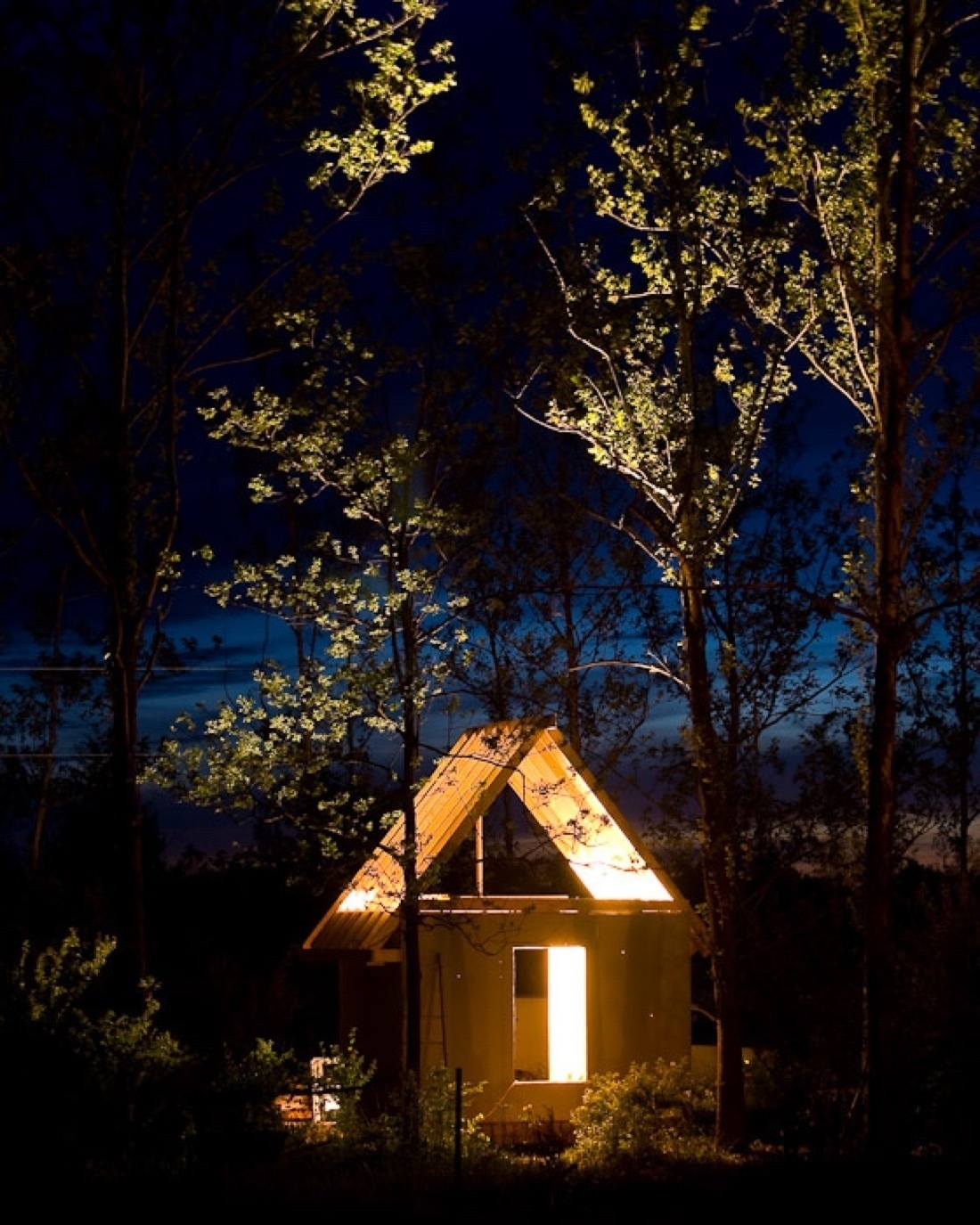 The kids’ cabin before the roof
The kids’ cabin before the roof
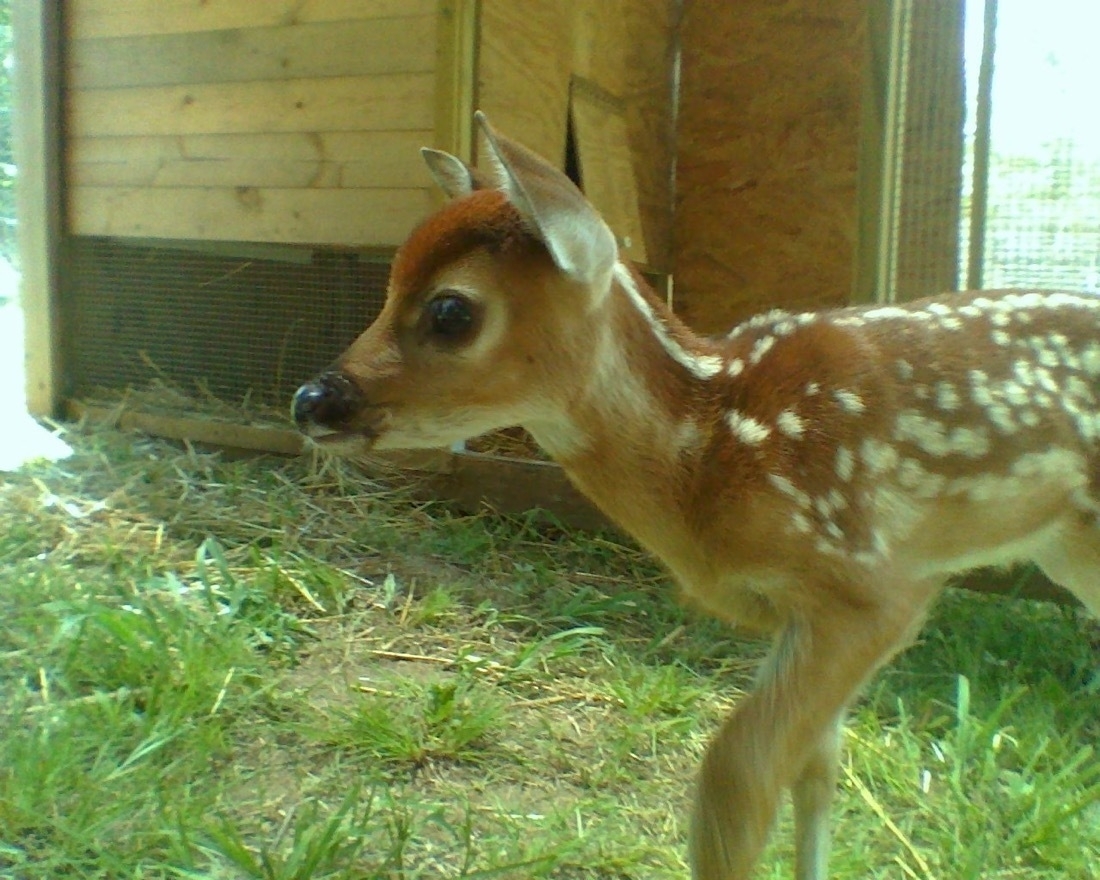 Petunia moves in
Petunia moves in
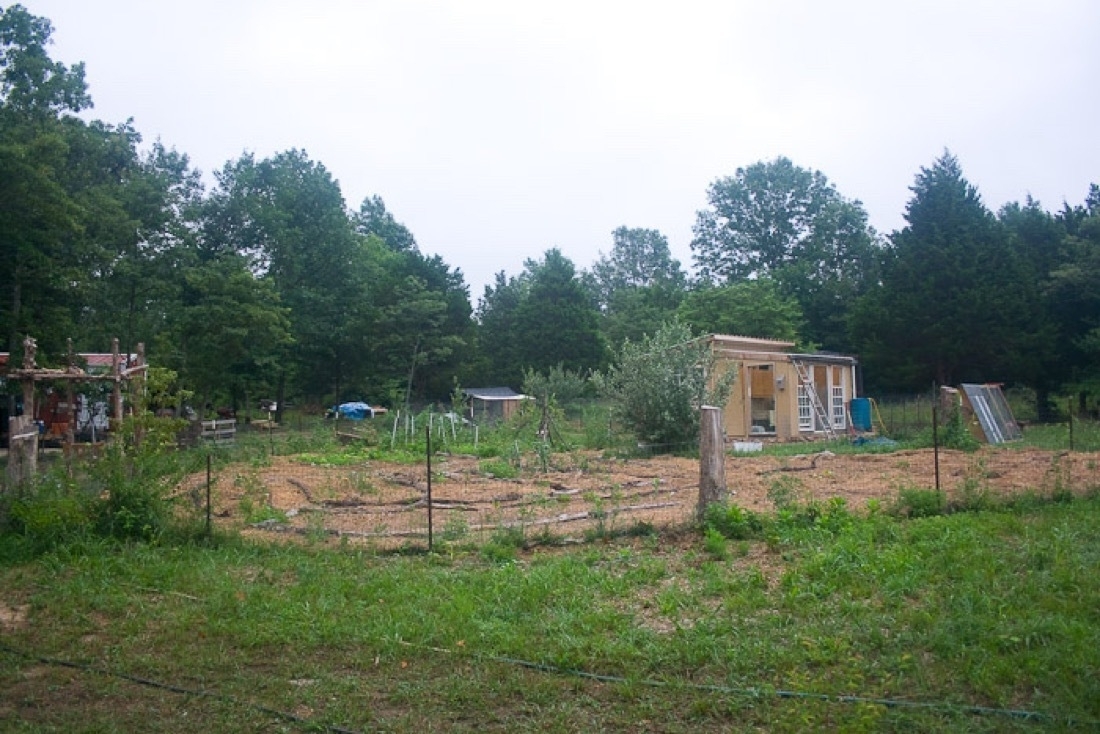 The spring kitchen garden, fully fenced in and mulched with cardboard and straw
The spring kitchen garden, fully fenced in and mulched with cardboard and straw
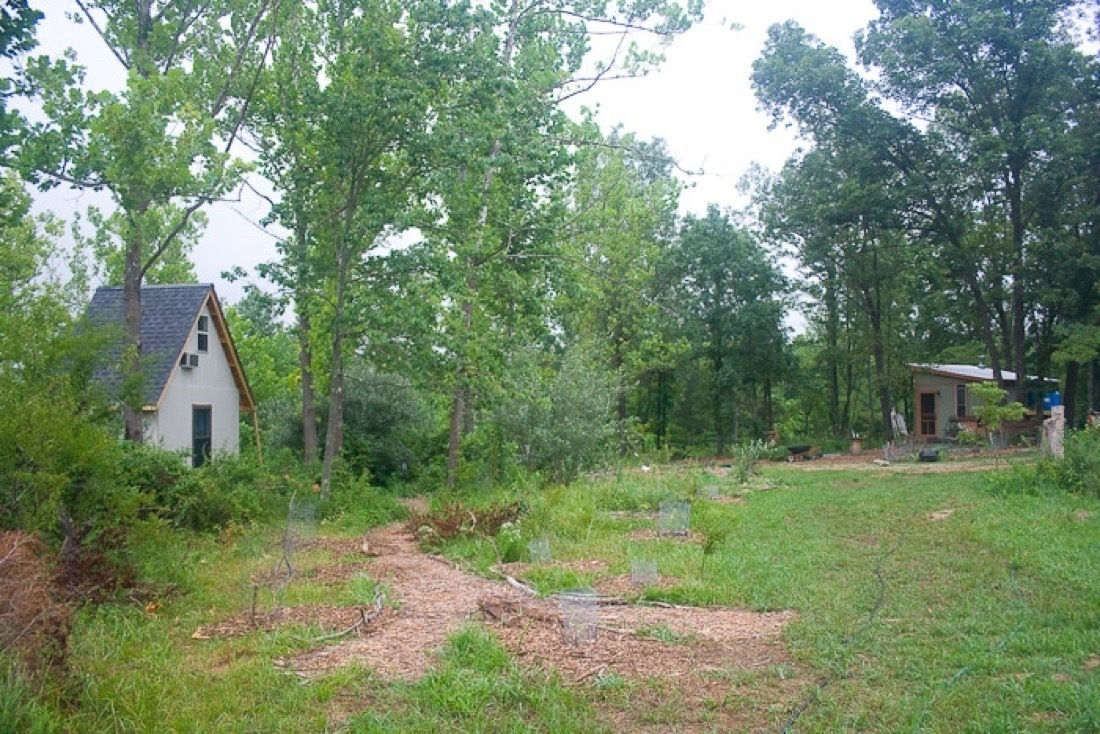 Mulched paths taking shape!
Mulched paths taking shape!
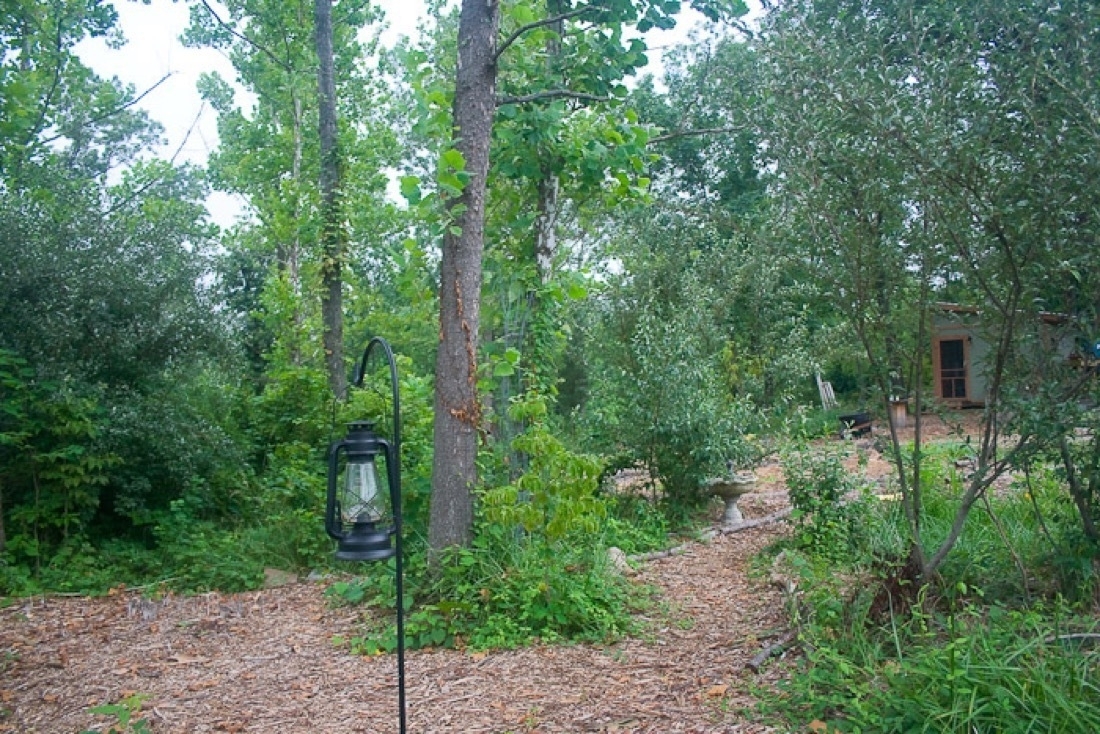 Paths
Paths
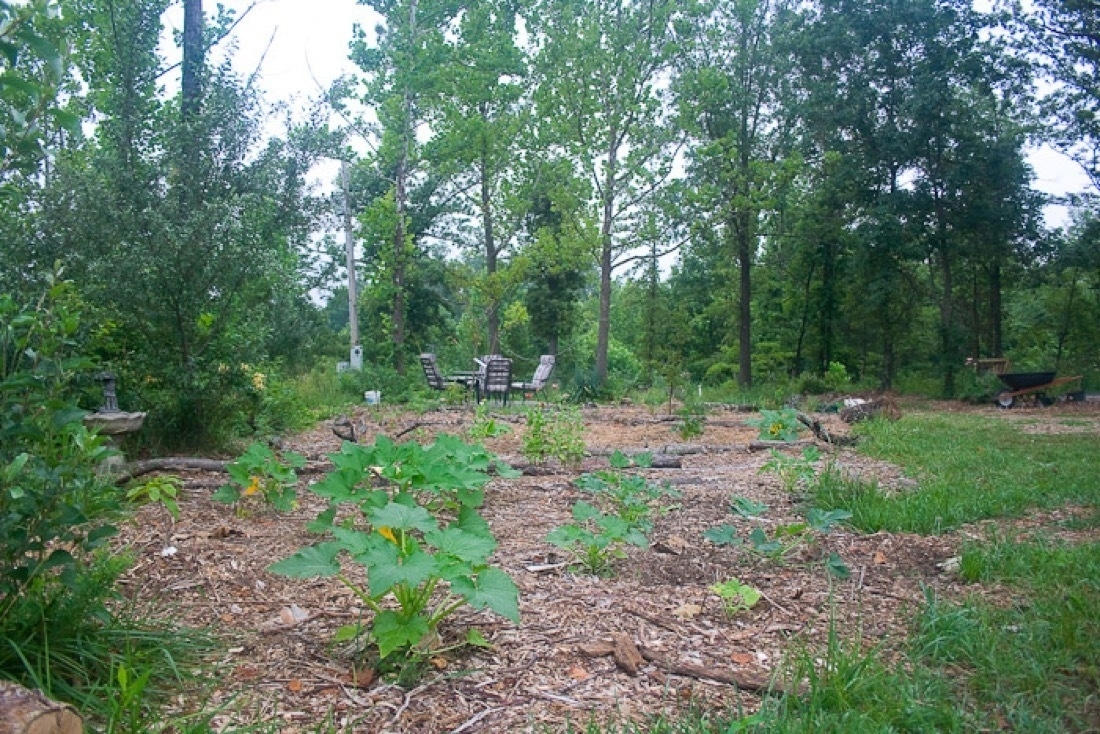 The early food forest interplanted with squash
The early food forest interplanted with squash
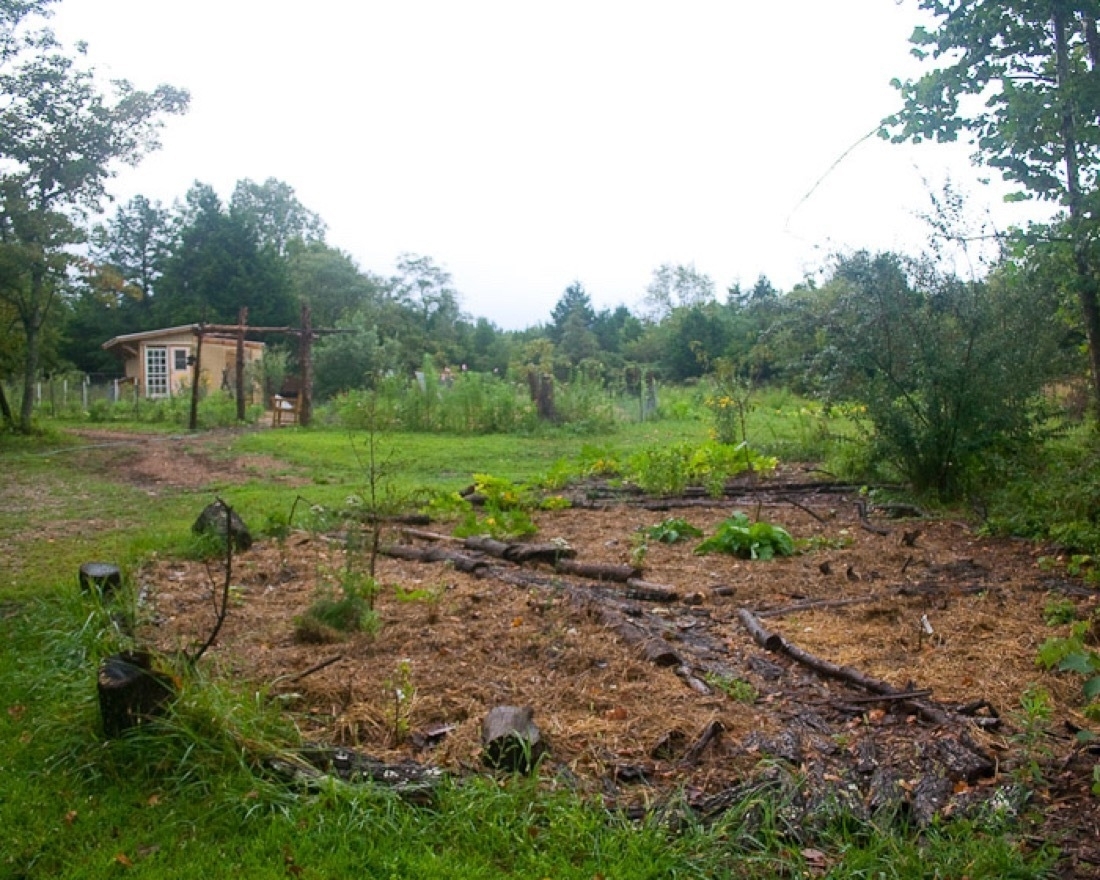 The food forest in front of my cabin with a mix of peaches, plums, gooseberry, currants and comfrey. Mulch with straw between small seedlings. Paths are defined by small logs and covered in bark and wood chip mulch.
The food forest in front of my cabin with a mix of peaches, plums, gooseberry, currants and comfrey. Mulch with straw between small seedlings. Paths are defined by small logs and covered in bark and wood chip mulch.
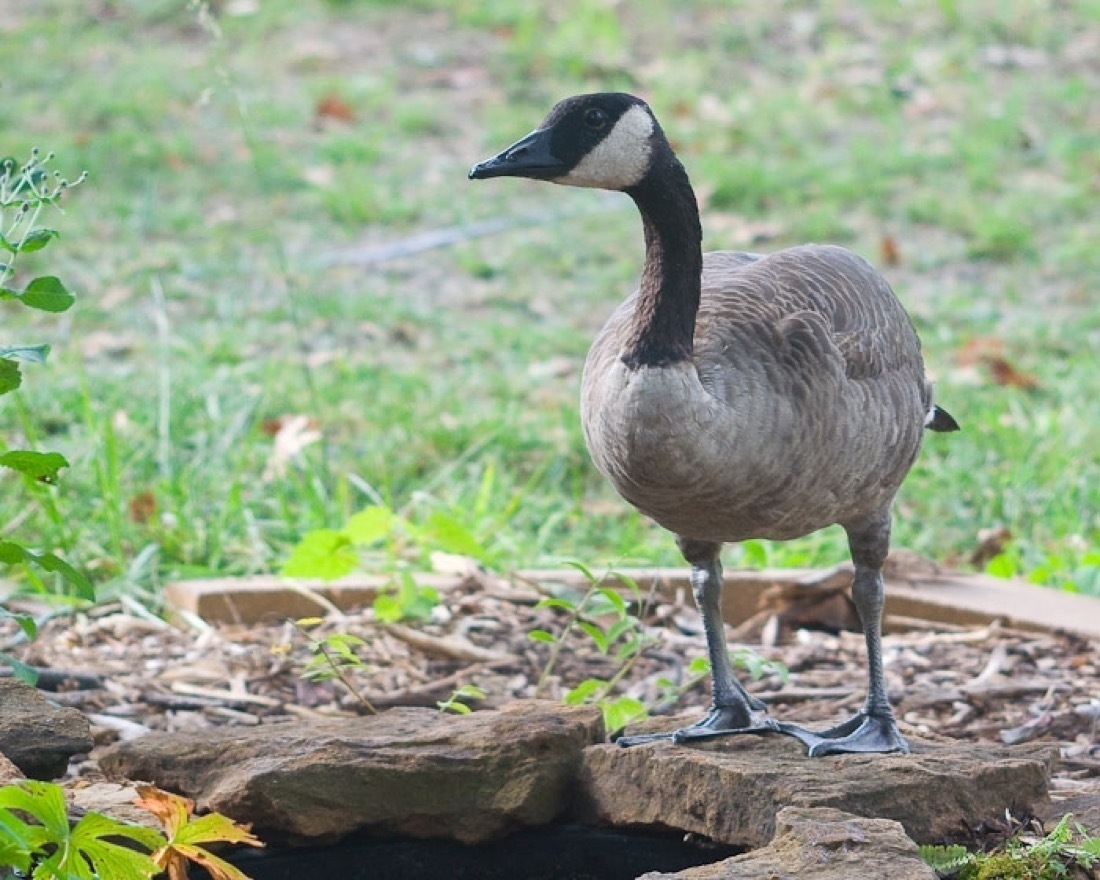
True story: Loretta the goose showed up one day in the summer and followed me to the outhouse which is back by the chicken coop. As I’m the only one here full time I leave the outhouse door open while doing my business as it’s a nice view. Well, this goose follows me up into the outhouse (3 steps) and proceeds to turn around to face outward and sits down on my feet. I almost died right there. When it was time to go I stood up and she did the same and then she stepped out ahead of me and followed me back to my cabin. And that was that, I’d been adopted by a Canada Goose. She spent the rest of the day hanging out around my cabin and left at sunset. I didn’t know if she’d be back but hoped she would.
She was back the following morning and spent the day with me. She just hung around outside the cabin, near the little pond I’d made for the frogs. At sunset she flew away. This was the daily routine for the next couple of months. She’d follow me around as I did my chores during the day and occasionally take a dip in the pond. There were times when I’d be doing chores and there would be a line behind me: the chickens, Petunia the deer (who was now free ranging) and Loretta the goose. On at least one occasion when I had guests over for dinner outside she stayed later than normal and as we stood/sat around a little fire after eating she stayed next to me making her various adorable little utterances. It seemed to me that it was her way of being in the conversation.
In late November or early December we had a few cold nights and the lake started to freeze over. As far as I could tell she didn’t spend any time in the lake but it seemed to be a cue to her. She flew off one evening and I never saw her again. I loved her and I still miss her.
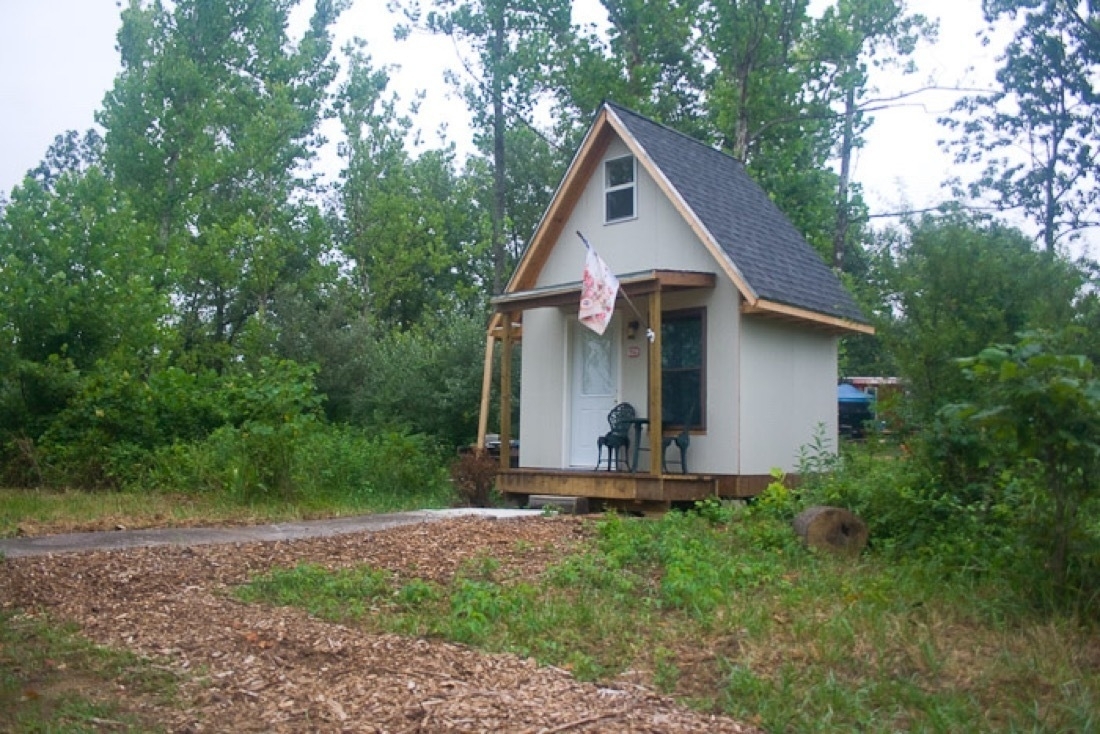 The mostly completed kids cabin
The mostly completed kids cabin
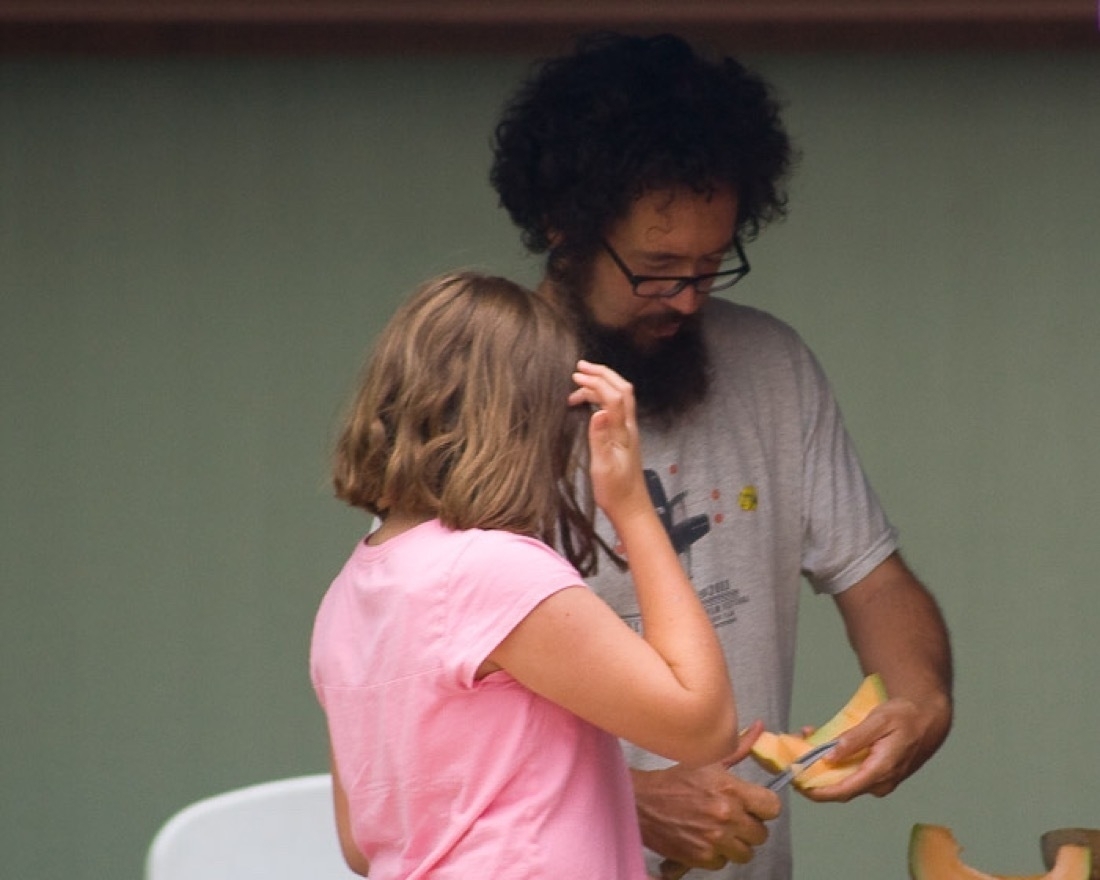 Cutting up a cantelope with my niece, Emma
Cutting up a cantelope with my niece, Emma
 Rain barrels and swales collecting rain in the food forest behind my cabin. The system wasn’t complete when the photo was taken hence the crazy arrangement!
Rain barrels and swales collecting rain in the food forest behind my cabin. The system wasn’t complete when the photo was taken hence the crazy arrangement!
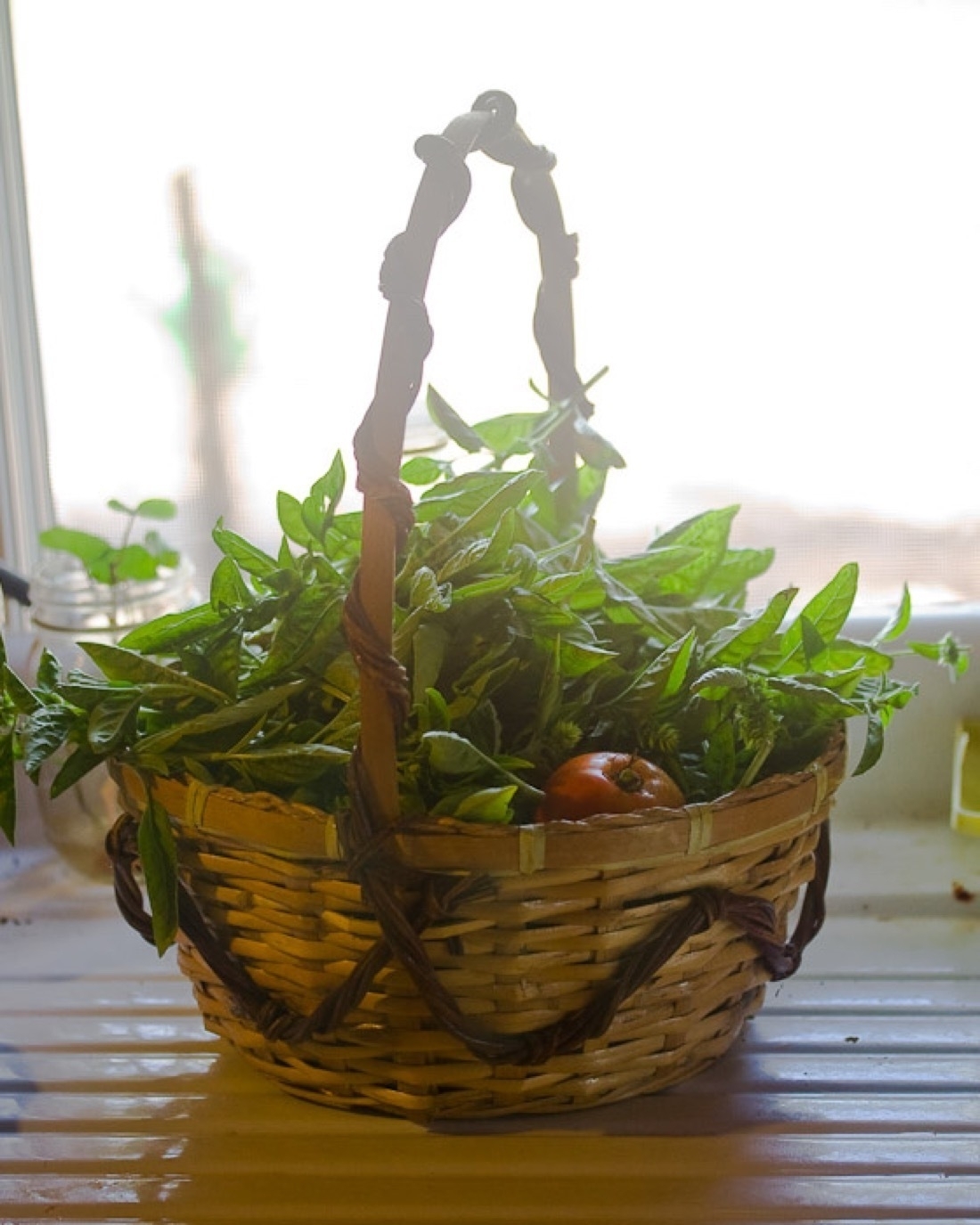 A basket of tomatoes and basil
A basket of tomatoes and basil

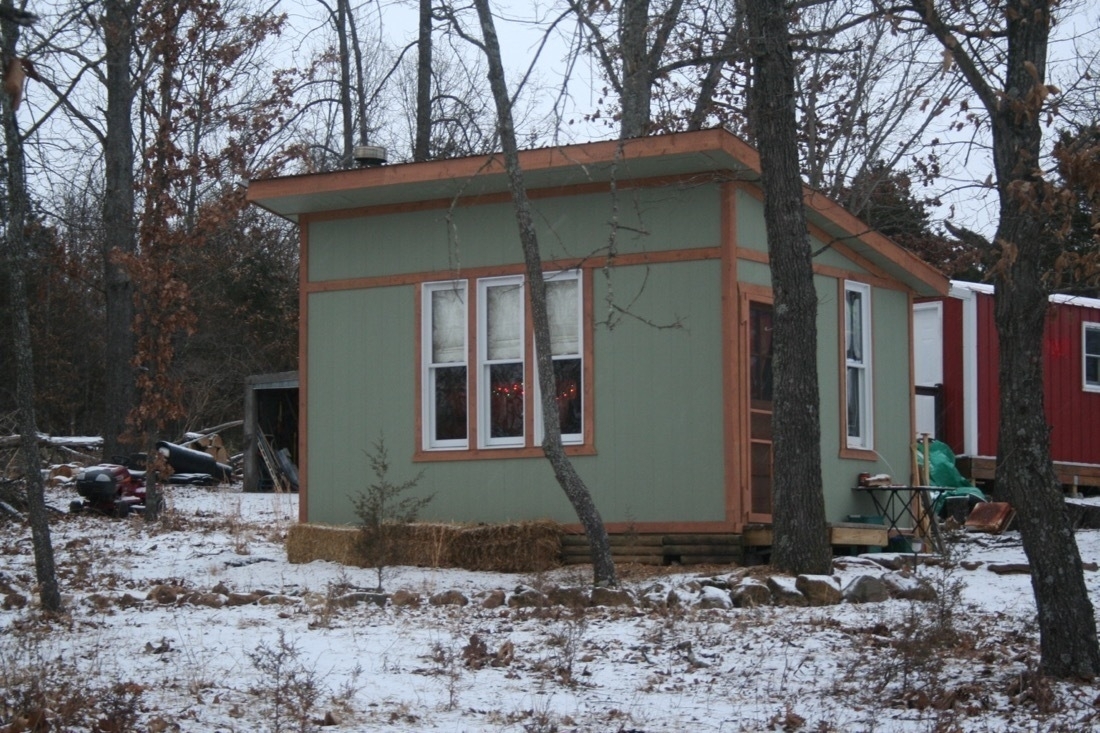
In 192 Square Feet Part 2 I wrote about my first winter living in my tiny house. Keeping warm with a wood stove without being too hot or too cold was difficult in a small space. Also, winter water challenges!
A scrolling multimedia exploration of the changes being brought by climate collapse.
“Researchers are no longer in doubt: Global warming has begun to make Norway warmer and wetter.”
An older post from 2016 about the process of building my tiny house and the first few months living here. 192 Square Feet
